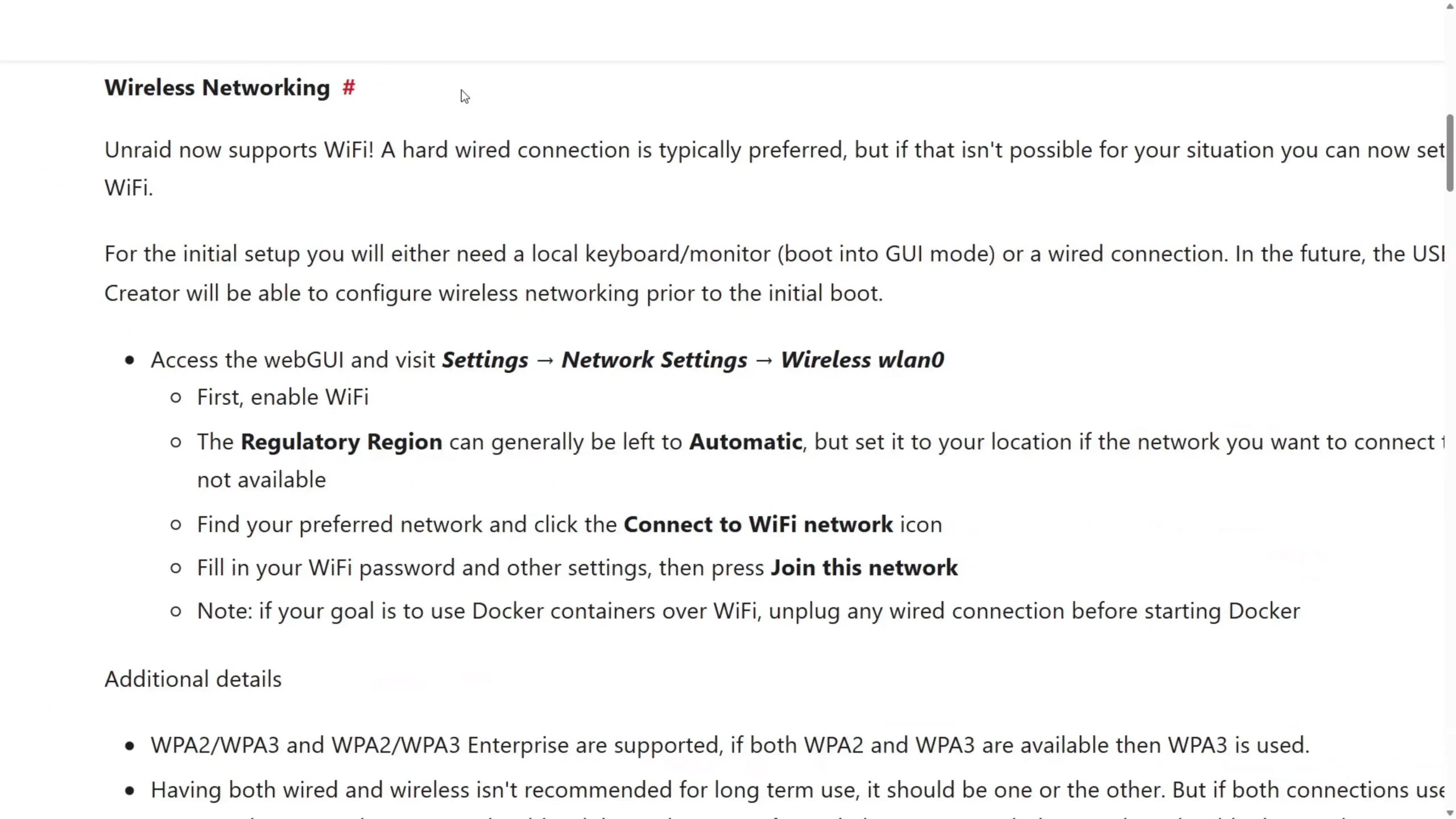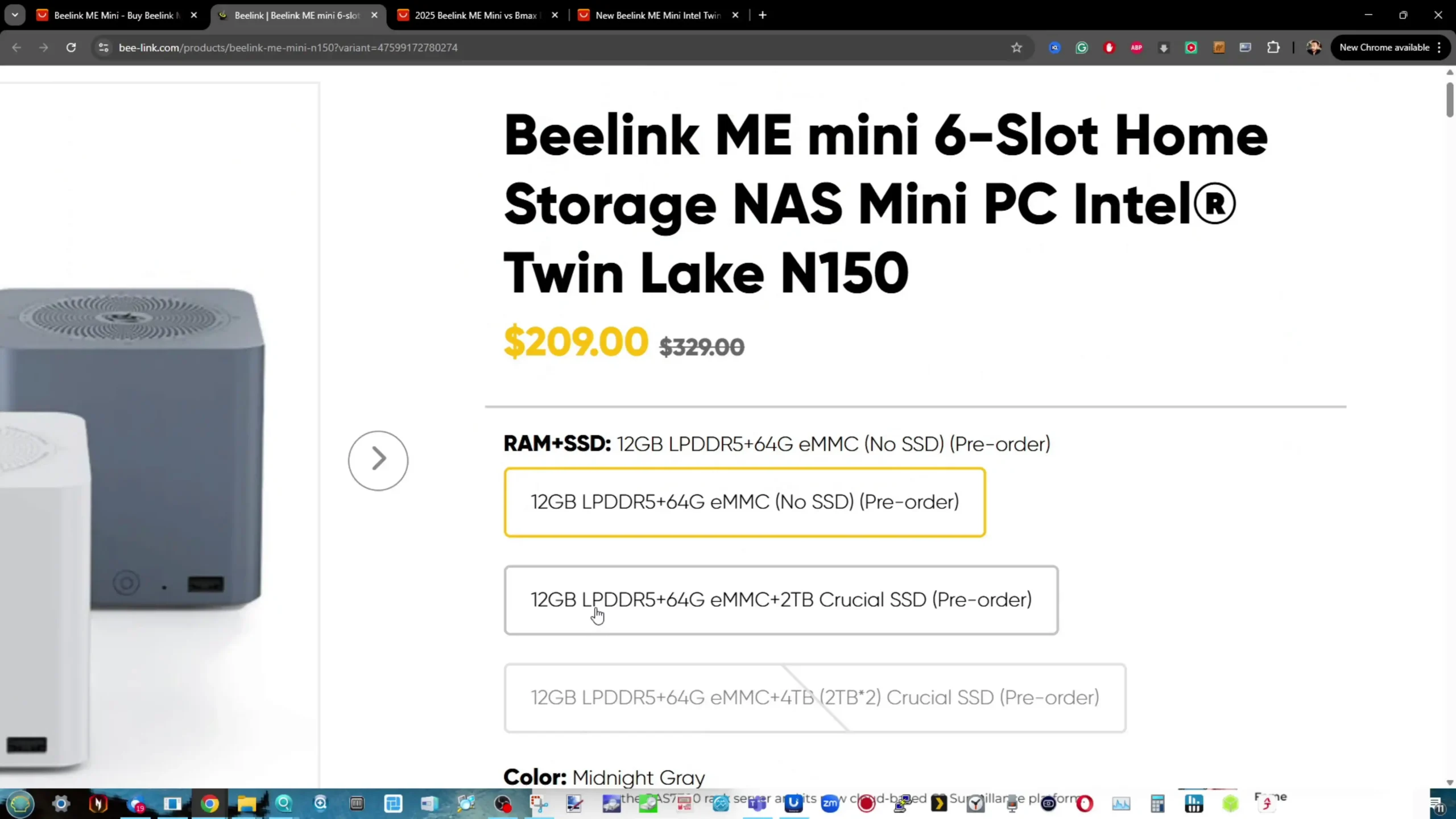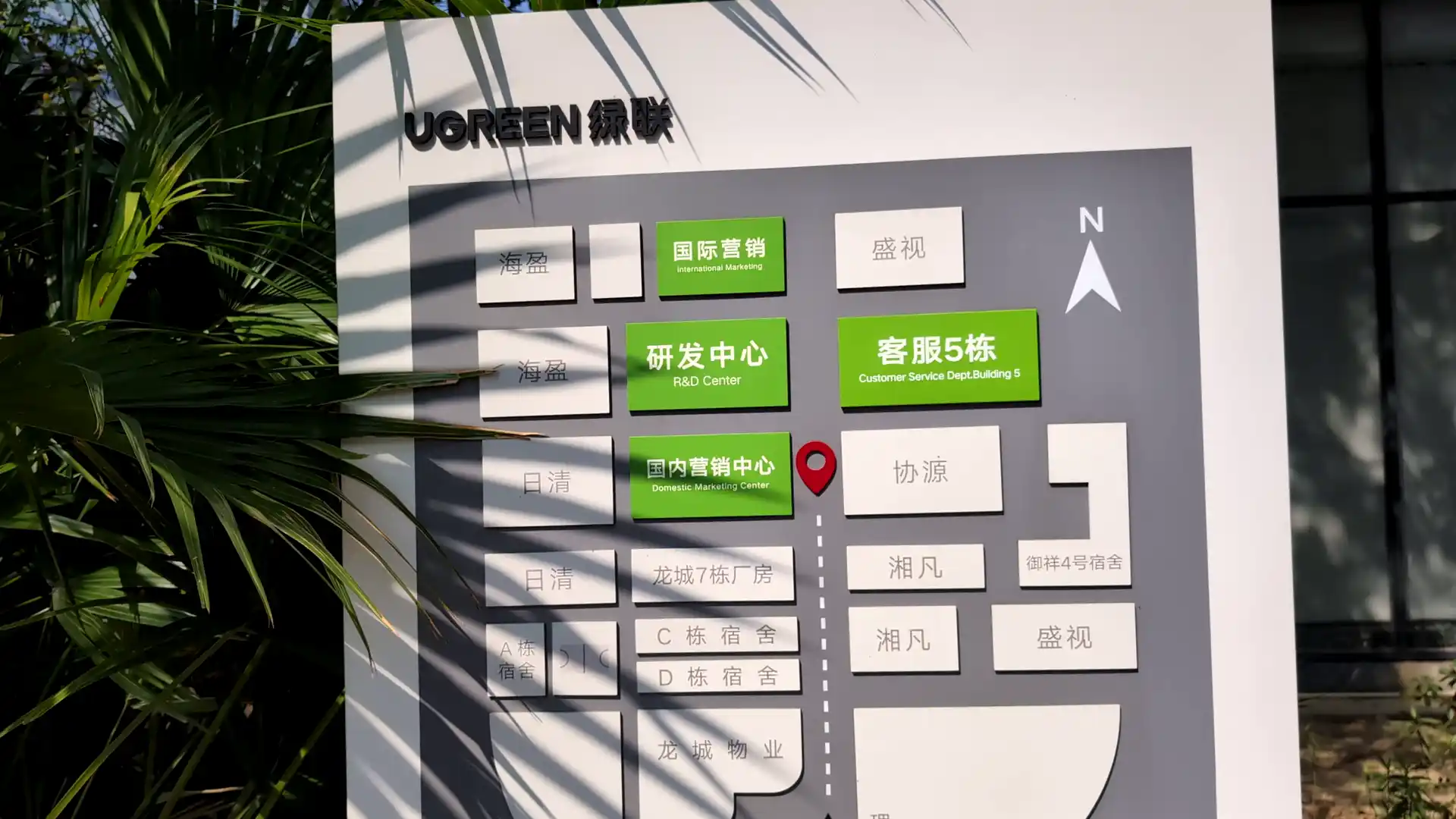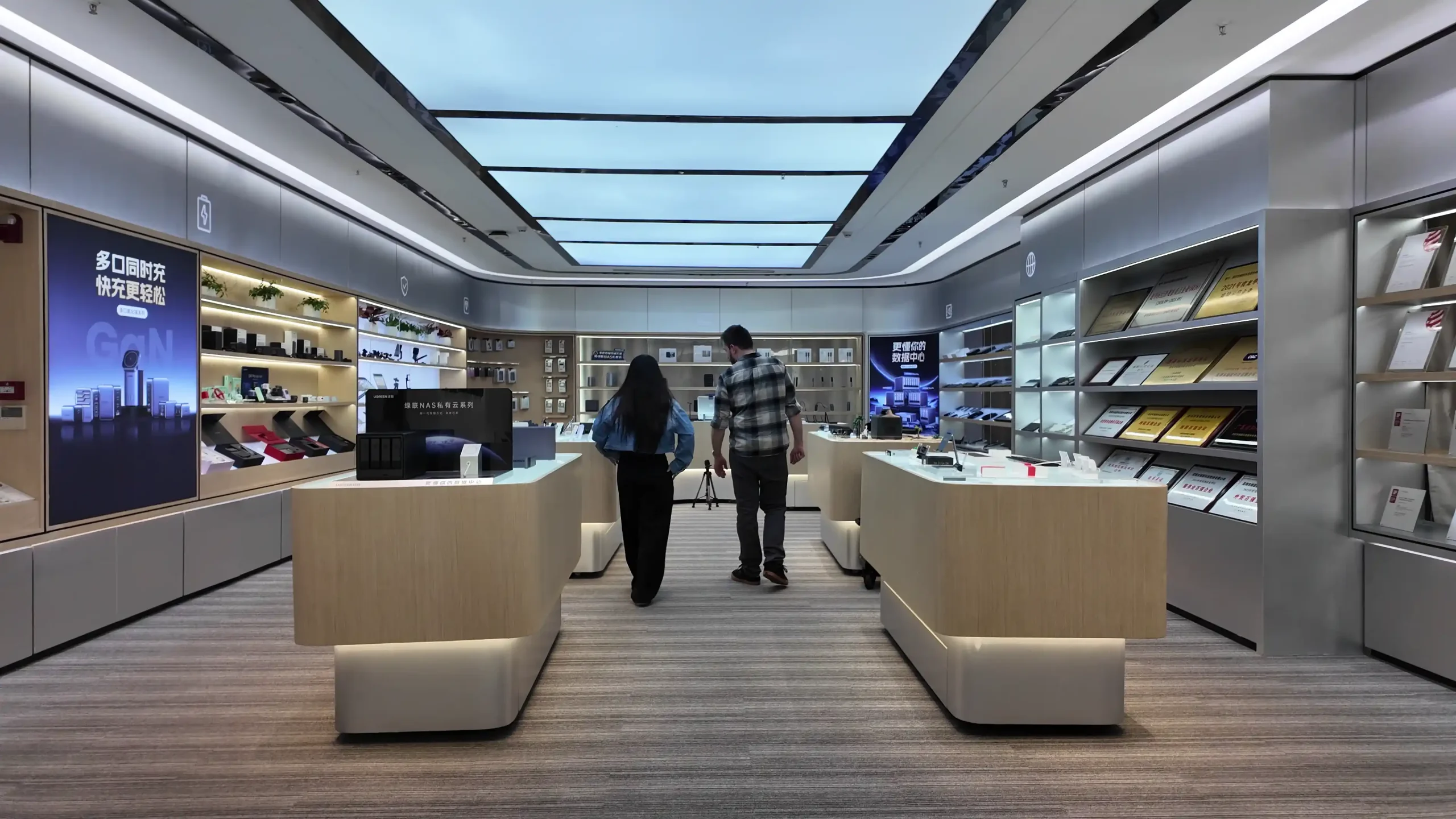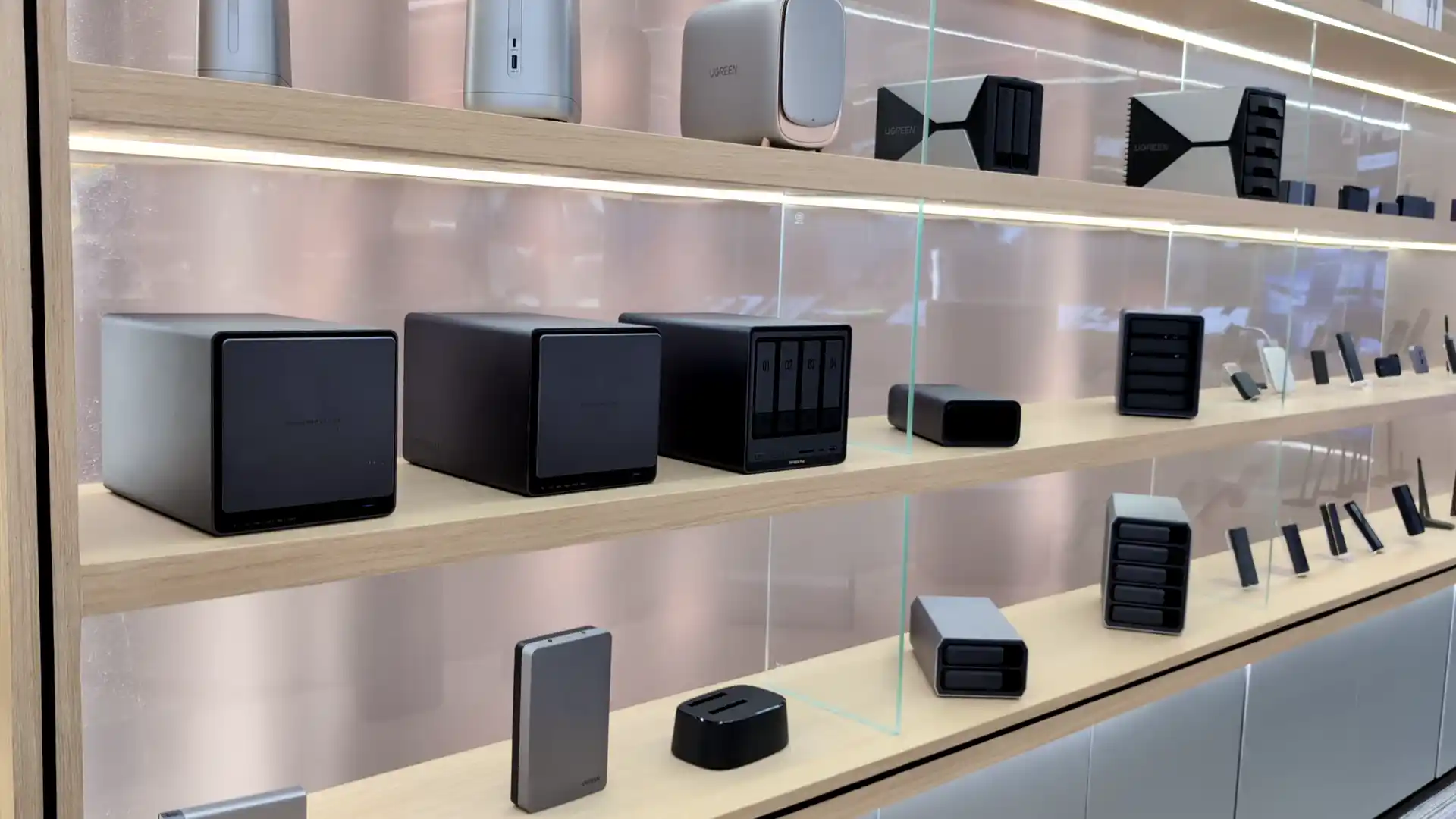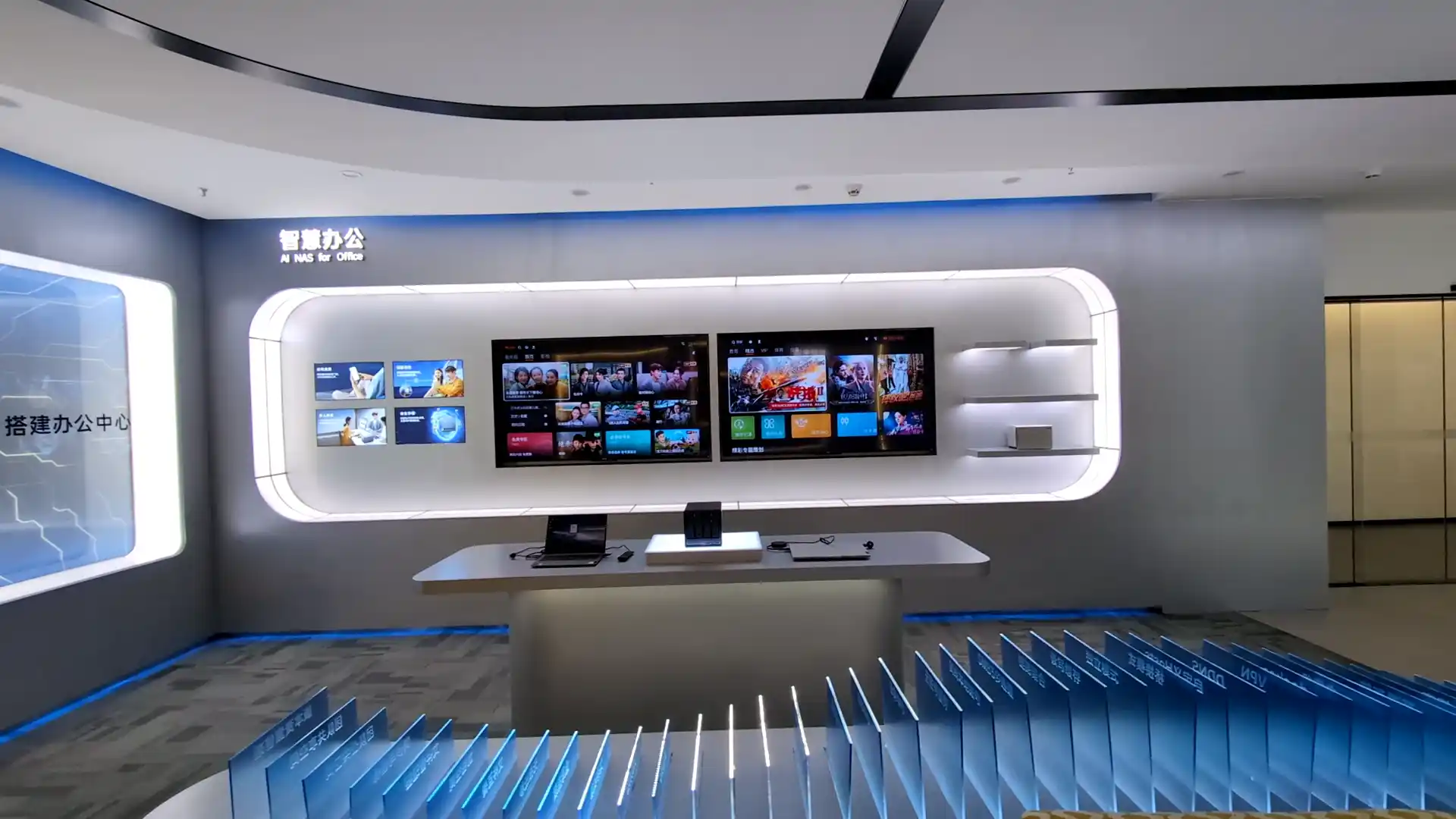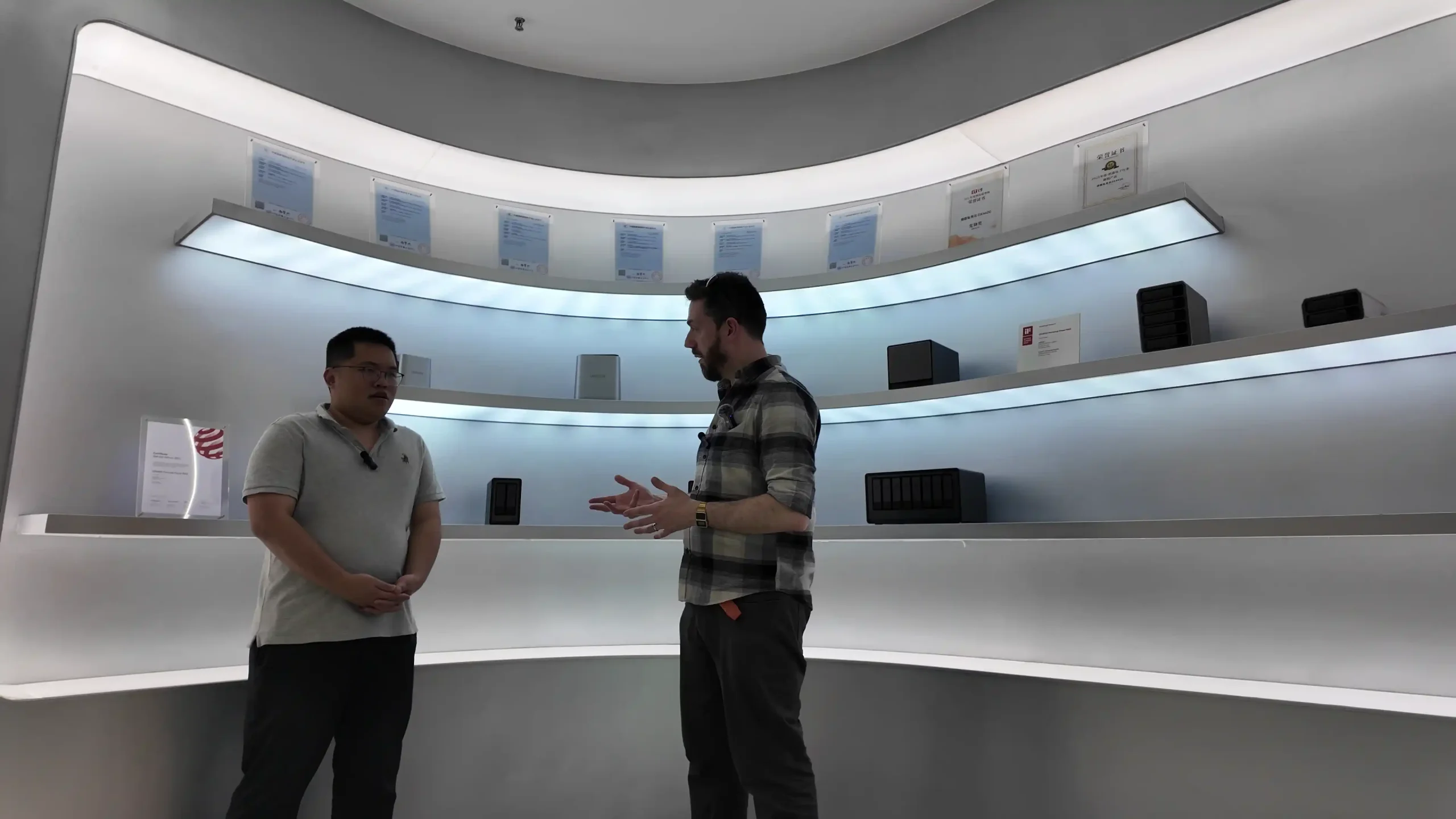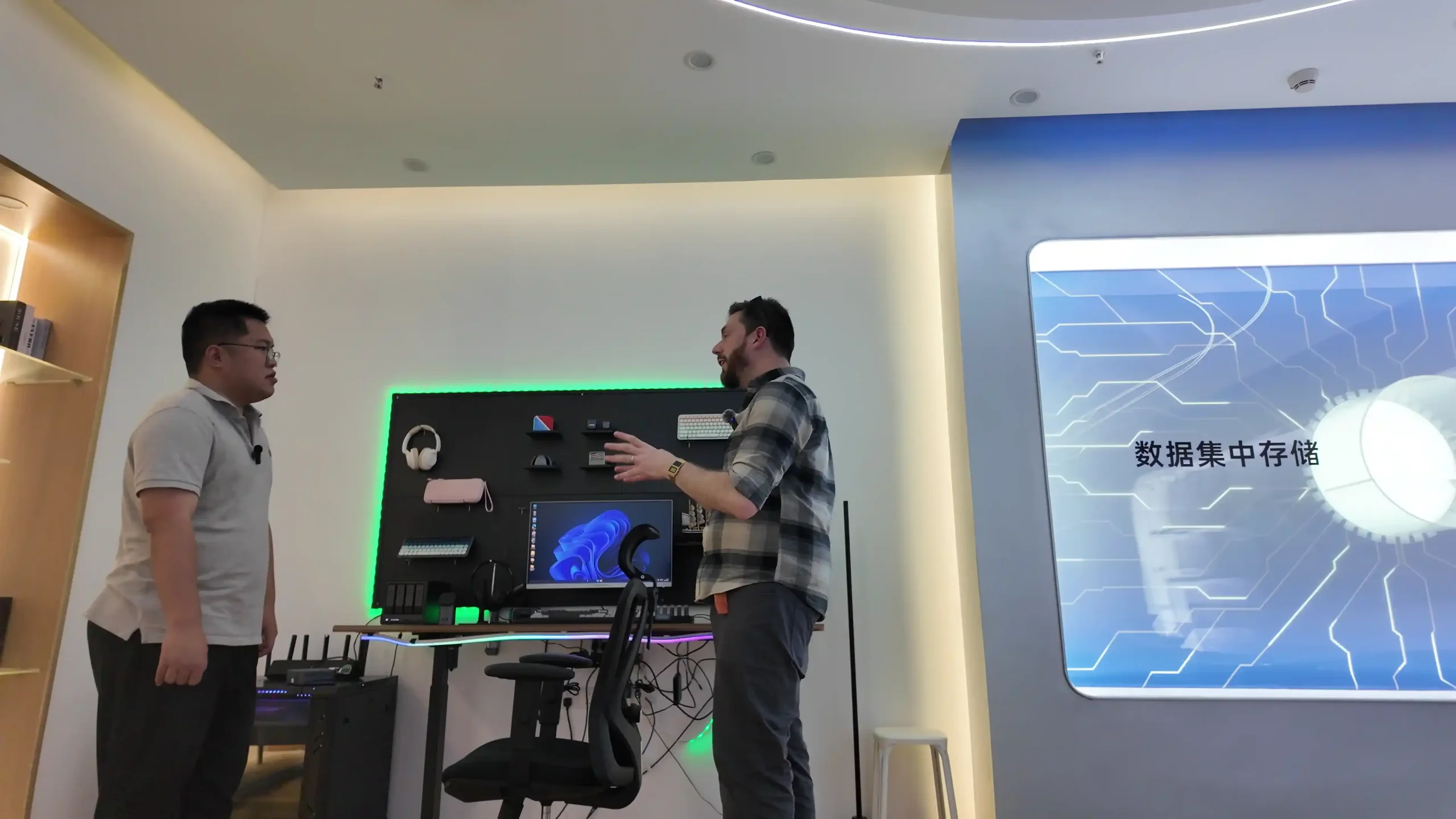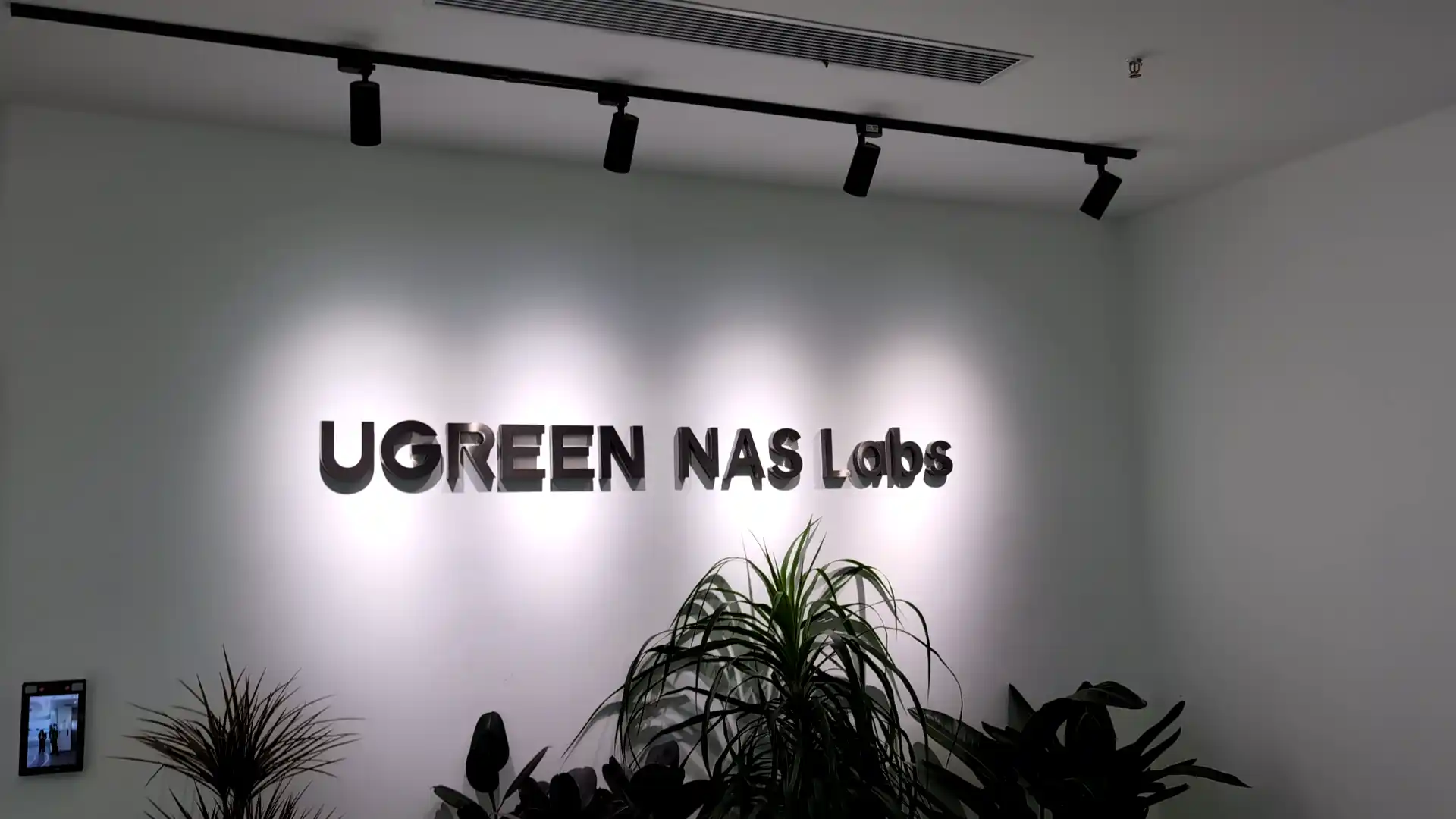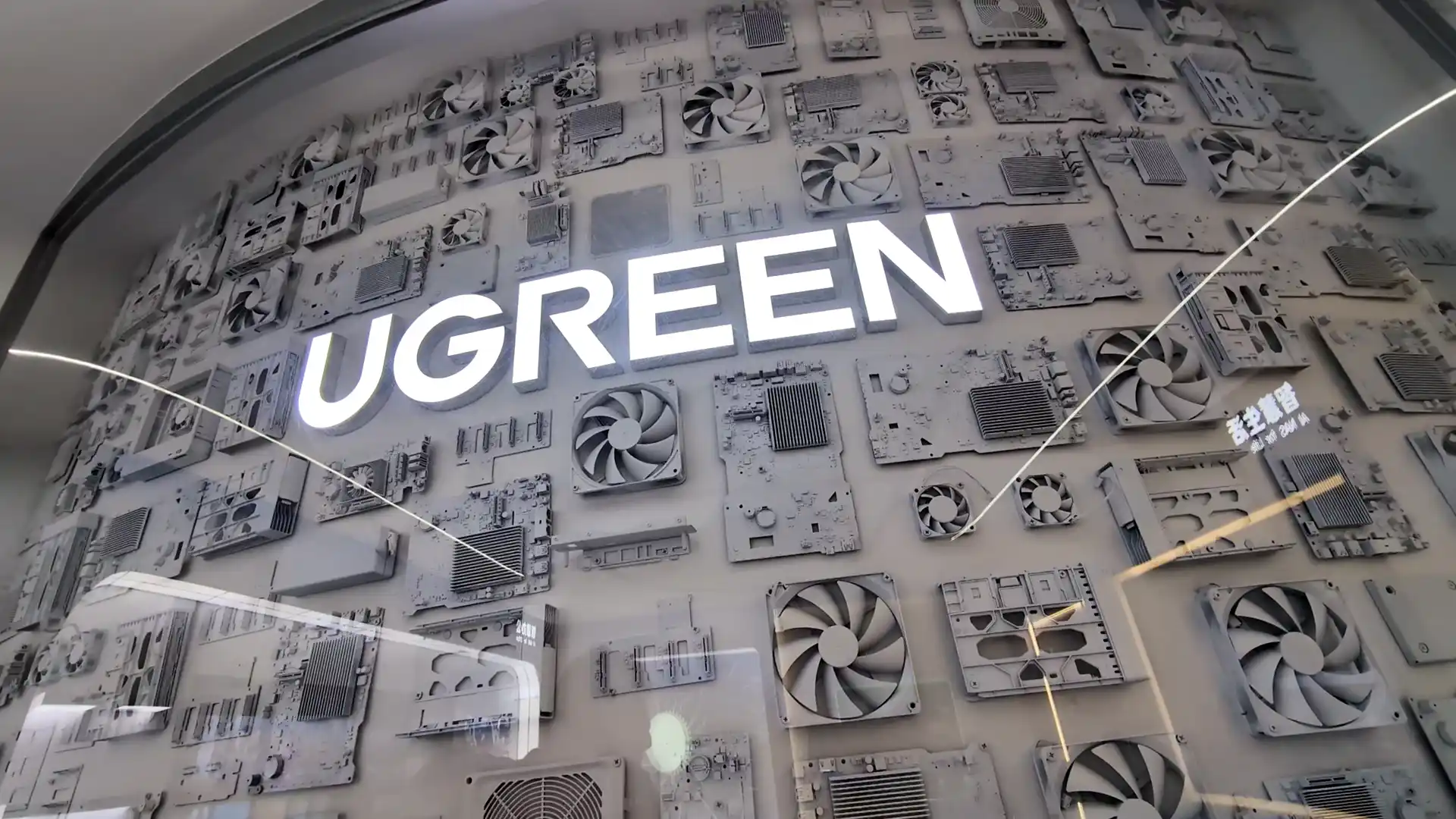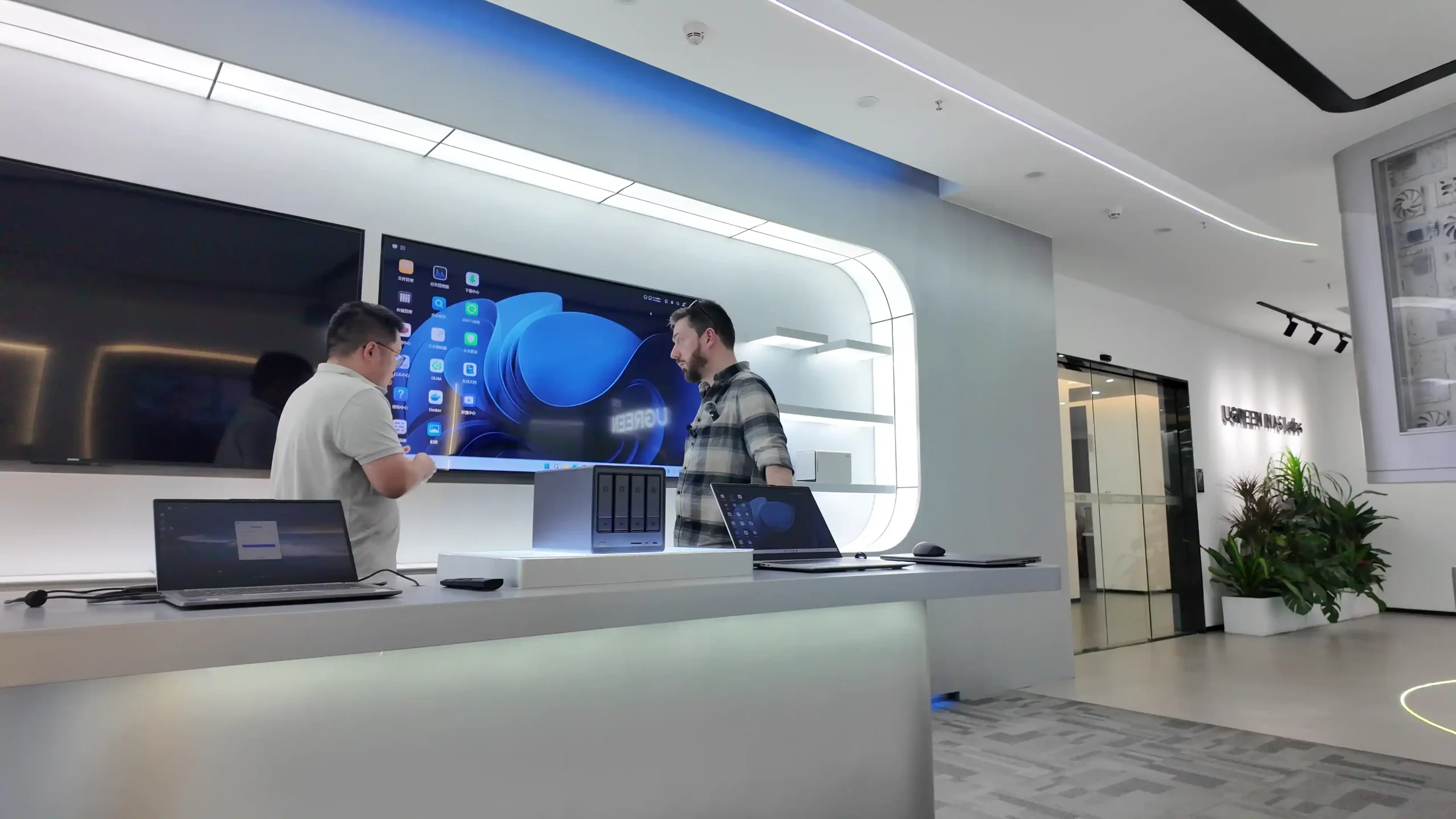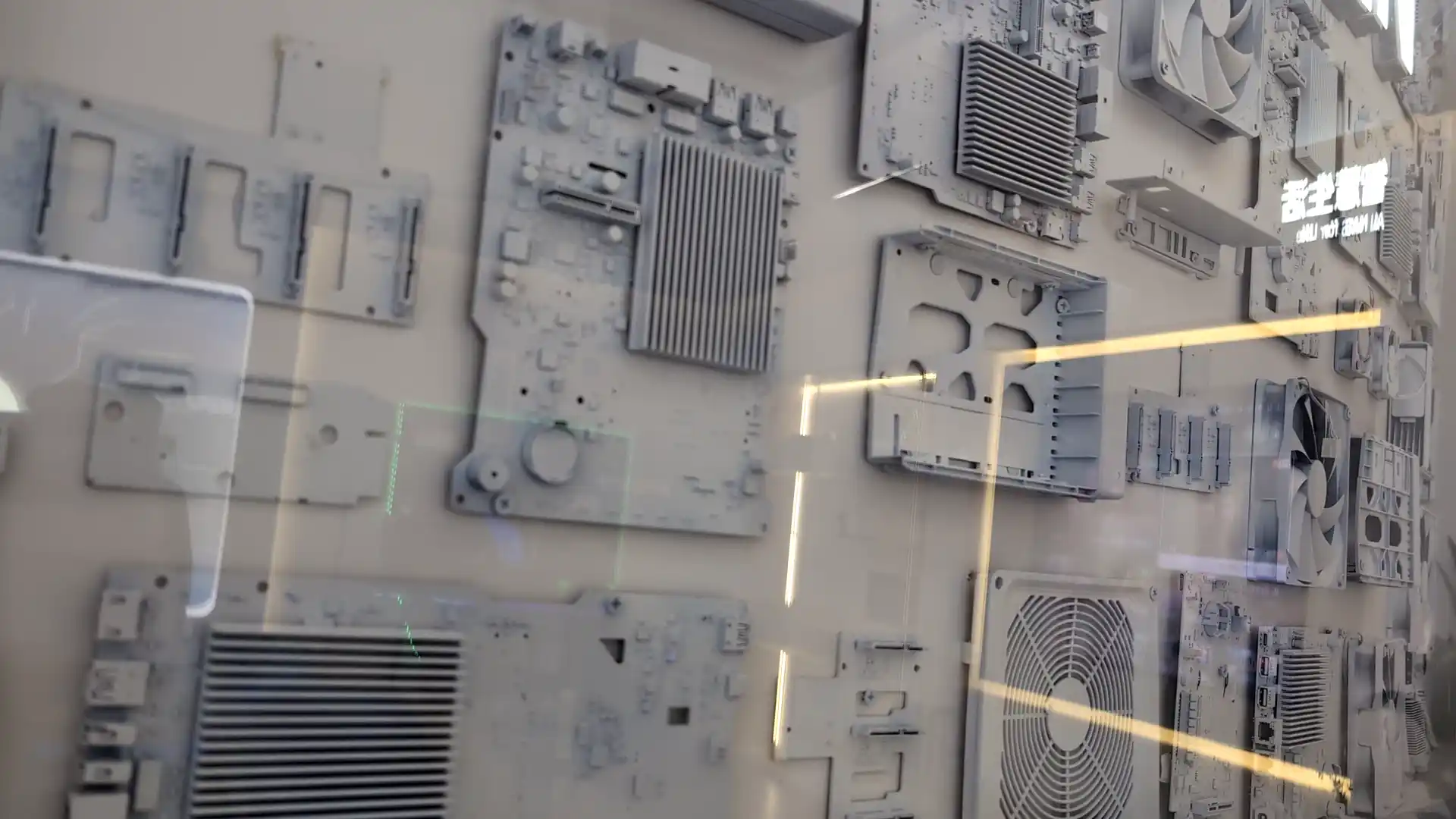Beelink ME Mini NAS Review – a Heatsink Sized NAS with 6 SSD Bays
Reviewing the Beelink ME Mini NAS – Flashy Brilliance
The Beelink ME Mini NAS is a compact, six-slot network-attached storage solution aimed squarely at home users seeking a quiet, efficient, and flexible storage platform without the cost or complexity of traditional full-size NAS systems. Measuring just 99mm in each dimension and built with a minimalist cube design, the unit is designed to blend into home environments such as living rooms, bedrooms, or home offices. At its core is the Intel Twin Lake N150 processor, a 4-core, 4-thread CPU with a 6W TDP and a burst clock of up to 3.6GHz, paired with 12GB of soldered LPDDR5 4800MHz memory. This combination targets scenarios such as home media streaming, light file serving, or soft routing, rather than heavy enterprise workloads.

The ME Mini supports six M.2 2280 SSD slots, delivering a maximum theoretical storage capacity of 24TB. This includes one Gen 3 x2 slot (designed for the OS) and five Gen 3 x1 slots for storage expansion.
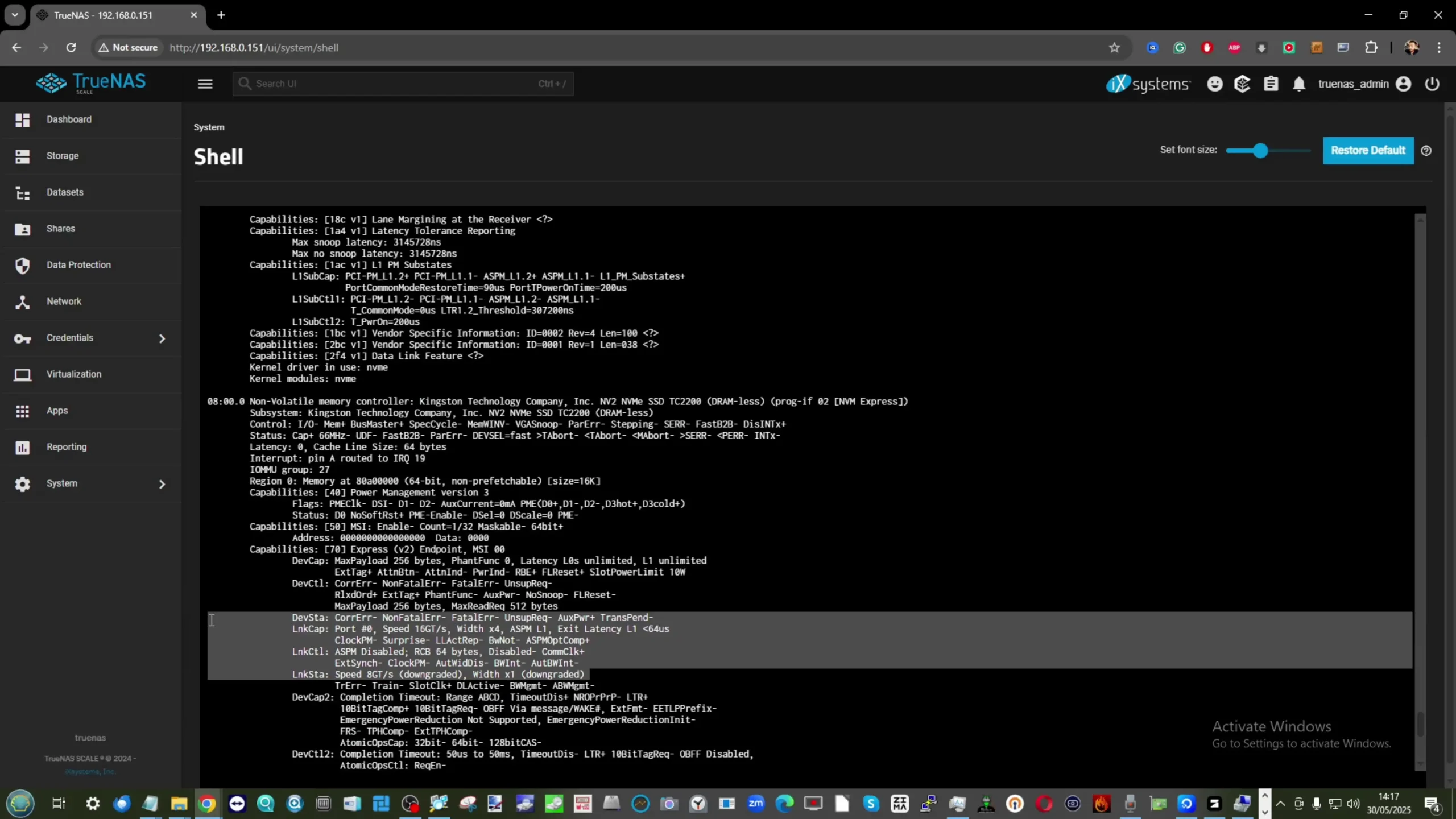 |
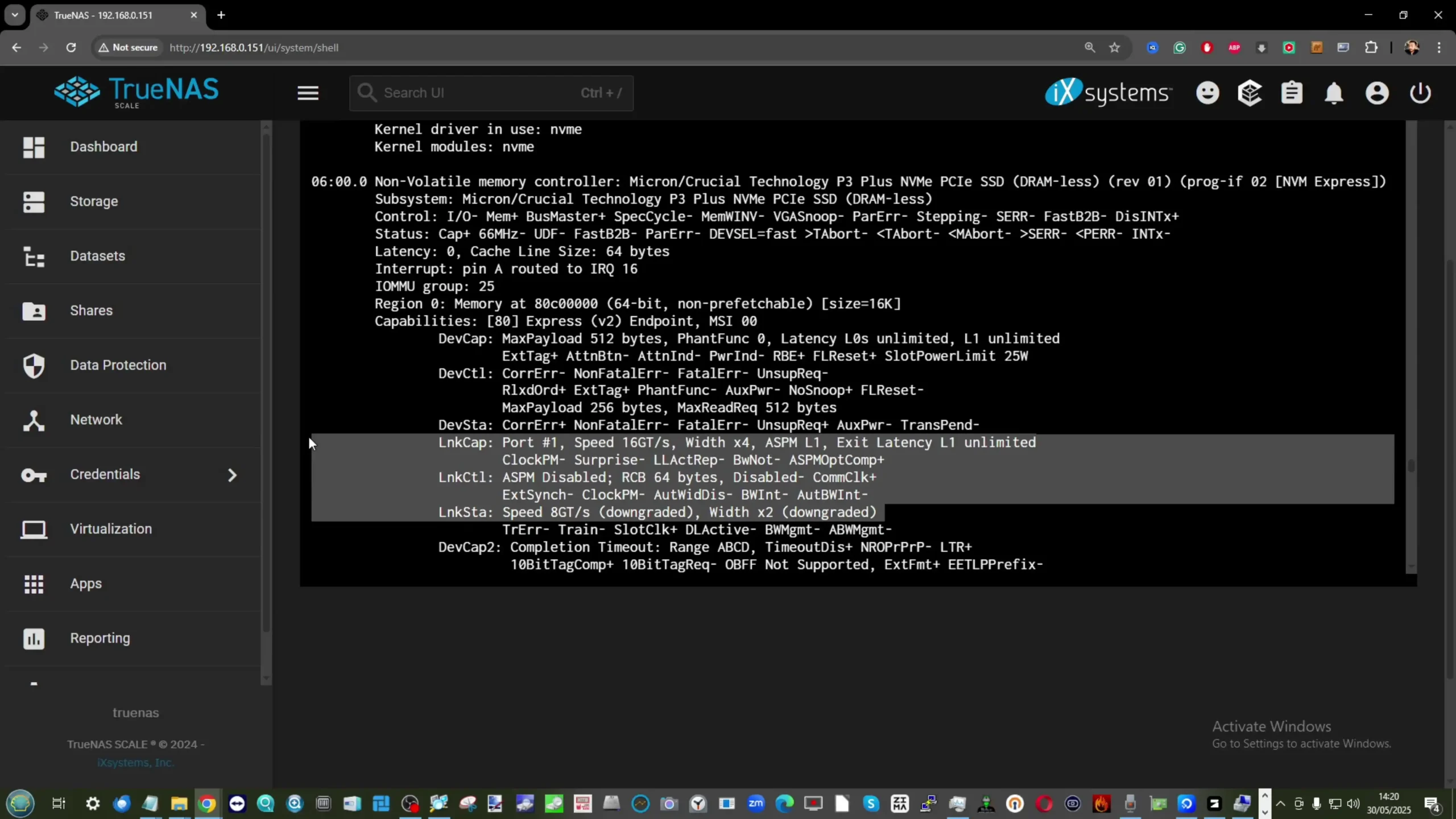 |
These SSD slots are actively cooled via an integrated heatsink and top-mounted silent fan, with thermal pads pre-attached for single-sided SSDs. Network connectivity includes dual Intel i226-V 2.5GbE ports and Wi-Fi 6 via an M.2 AX101 module, offering options for wired link aggregation or wireless deployment. Designed to support operating systems such as Unraid, OpenMediaVault, and TrueNAS, the ME Mini provides sufficient hardware for media servers like Plex or Jellyfin, personal backup, or even entry-level virtualization tasks. With a built-in power supply and no reliance on bulky external adapters, the device prioritizes simplicity and space efficiency.

Beelink ME Mini NAS Review – Quick Conclusion
The Beelink ME Mini NAS stands out as a compact, energy-efficient, and well-balanced storage solution tailored for home users seeking quiet and capable performance without the complexity of larger NAS systems. With support for six M.2 NVMe SSDs—one at Gen 3 x2 and five at Gen 3 x1—it offers up to 24TB of storage in a 99mm cube form factor, complete with an internal power supply and silent fan-assisted cooling. Its Intel Twin Lake N150 CPU and 12GB of LPDDR5 memory provide enough processing headroom for tasks like 4K media streaming, personal backups, and soft routing, while dual 2.5GbE LAN ports and Wi-Fi 6 expand its deployment options. Though the fixed memory and limited PCIe bandwidth on most slots constrain scalability, the thermal efficiency, low power draw (as low as 6.9W idle), and reliable Crucial SSD options make it a compelling value proposition. It’s not aimed at high-performance or prosumer use, but for users building a quiet, tidy, and effective DIY NAS at home, the ME Mini delivers far more than its size suggests.
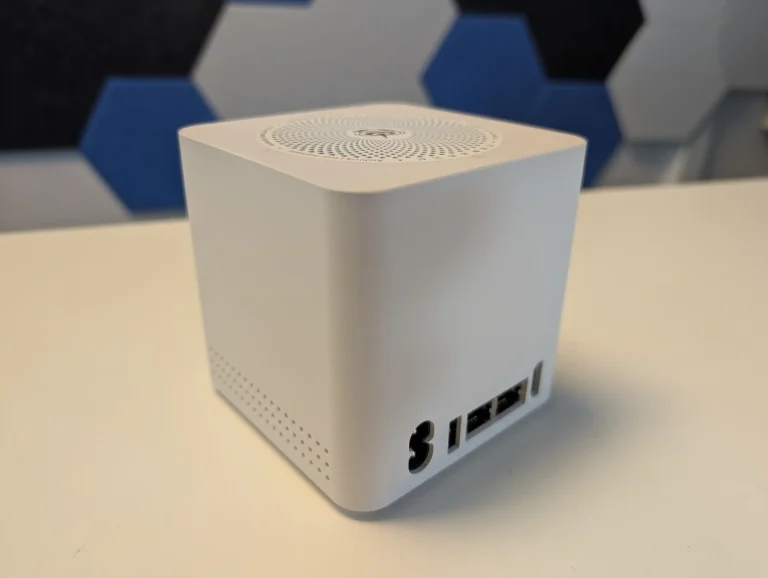

8.8
 Compact cube design (99x99x99mm) ideal for discreet home deployment
Compact cube design (99x99x99mm) ideal for discreet home deployment Supports up to 6x M.2 NVMe SSDs with total capacity up to 24TB
Supports up to 6x M.2 NVMe SSDs with total capacity up to 24TB Integrated PSU eliminates bulky external power adapters
Integrated PSU eliminates bulky external power adapters Dual 2.5GbE LAN ports with link aggregation support
Dual 2.5GbE LAN ports with link aggregation support Wi-Fi 6 and UnRAID7 Support means not limited to 2x2.5G
Wi-Fi 6 and UnRAID7 Support means not limited to 2x2.5G Low power consumption (as low as 6.9W idle, ~30W peak with full load)
Low power consumption (as low as 6.9W idle, ~30W peak with full load) Silent fan and effective internal thermal management via large heatsink
Silent fan and effective internal thermal management via large heatsink Includes Crucial-branded SSDs in pre-configured options for reliability
Includes Crucial-branded SSDs in pre-configured options for reliability
 Five of the six SSD slots are limited to PCIe Gen 3 x1 bandwidth
Five of the six SSD slots are limited to PCIe Gen 3 x1 bandwidth Memory is soldered and non-upgradable
Memory is soldered and non-upgradable Not 10GbE Upgradable (maybe m.2 adapter - messy)
Not 10GbE Upgradable (maybe m.2 adapter - messy) Bottom panel retains heat due to lack of active ventilation
Bottom panel retains heat due to lack of active ventilation
Where to Buy a Product





![]()
![]()

VISIT RETAILER ➤






![]()
![]()

VISIT RETAILER ➤
|
Check Amazon in Your Region for the Beelink ME Mini NAS ($329 4/6) |
Check AliExpress for the Beelink ME Mini NAS ($344 4/6) |
Check the Official Beelink Site for the ME Mini NAS ($209 4/6) |
Beelink ME Mini NAS – Design and Storage
Visually, the Beelink ME Mini sets itself apart from other mini NAS systems with its symmetrical cube-shaped design, measuring 99x99x99mm. Available in three color variants—Pearl White, Midnight Grey, and Peacock Blue—the device adopts a subtle, neutral aesthetic intended to fit into typical home environments without drawing unnecessary attention. The enclosure features rubber feet for vertical stability and ventilation grilles located at both the top and bottom, supporting a passive vertical airflow design that assists with heat dissipation.
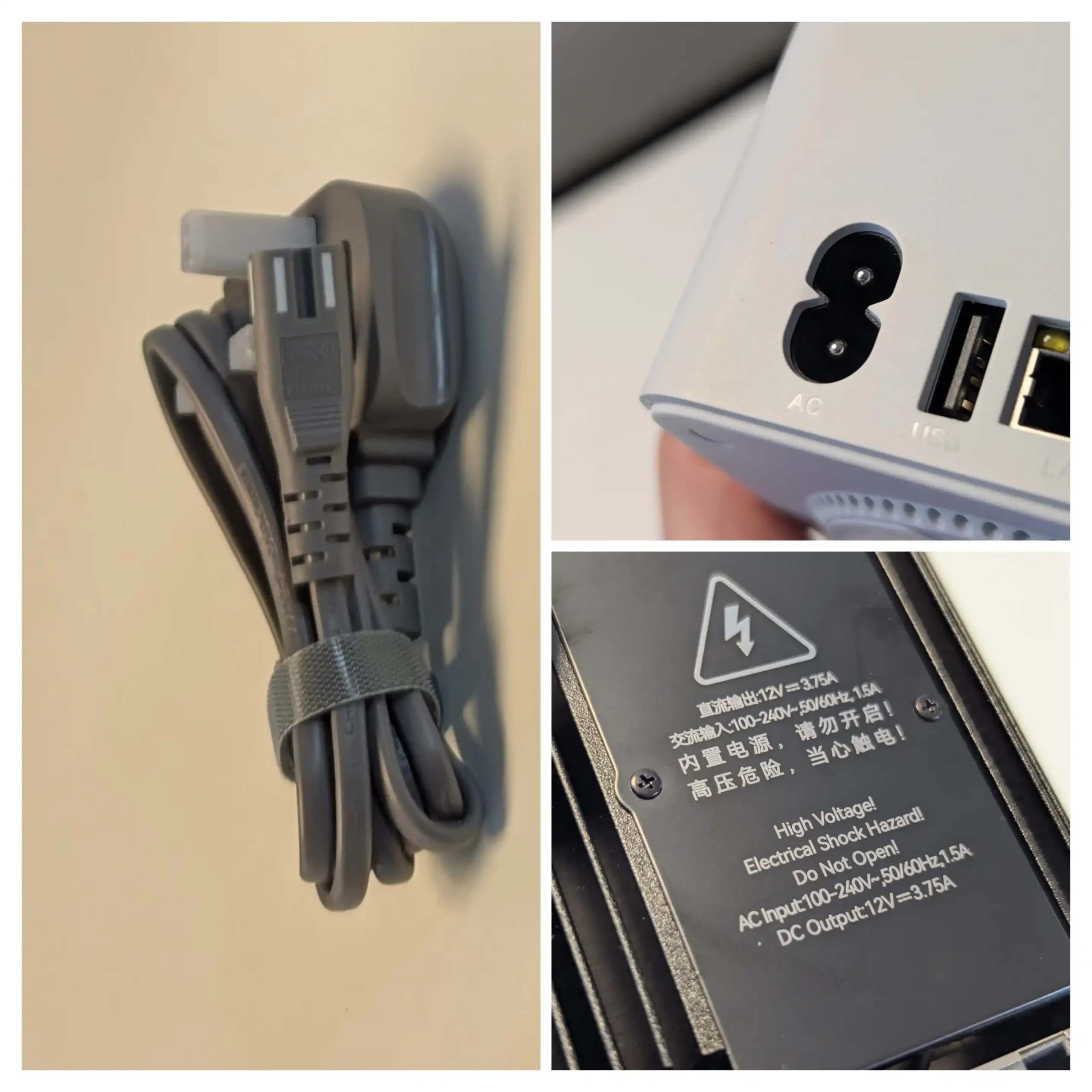
Despite its small footprint, the chassis houses an integrated power supply unit (PSU), which eliminates the need for bulky external power bricks and simplifies cable management—an uncommon but notable design feature in NAS devices of this size.

Storage capacity is a central feature of the ME Mini, with support for up to six M.2 SSDs in 2280 format, totaling a maximum of 24TB. These slots are all positioned internally in a dual-sided configuration—three on each internal face—and interface via PCIe Gen 3. Five of the slots operate at Gen 3 x1 bandwidth, while one (typically slot 4) operates at Gen 3 x2, recommended for installing the OS. The use of M.2 NVMe SSDs enables dense storage with minimal thermal output compared to 3.5” drives, which aligns with the ME Mini’s aim of delivering high-capacity, low-noise storage for homes. There is also a 64GB eMMC module included by default, recommended for lightweight OS installations or router-based platforms.
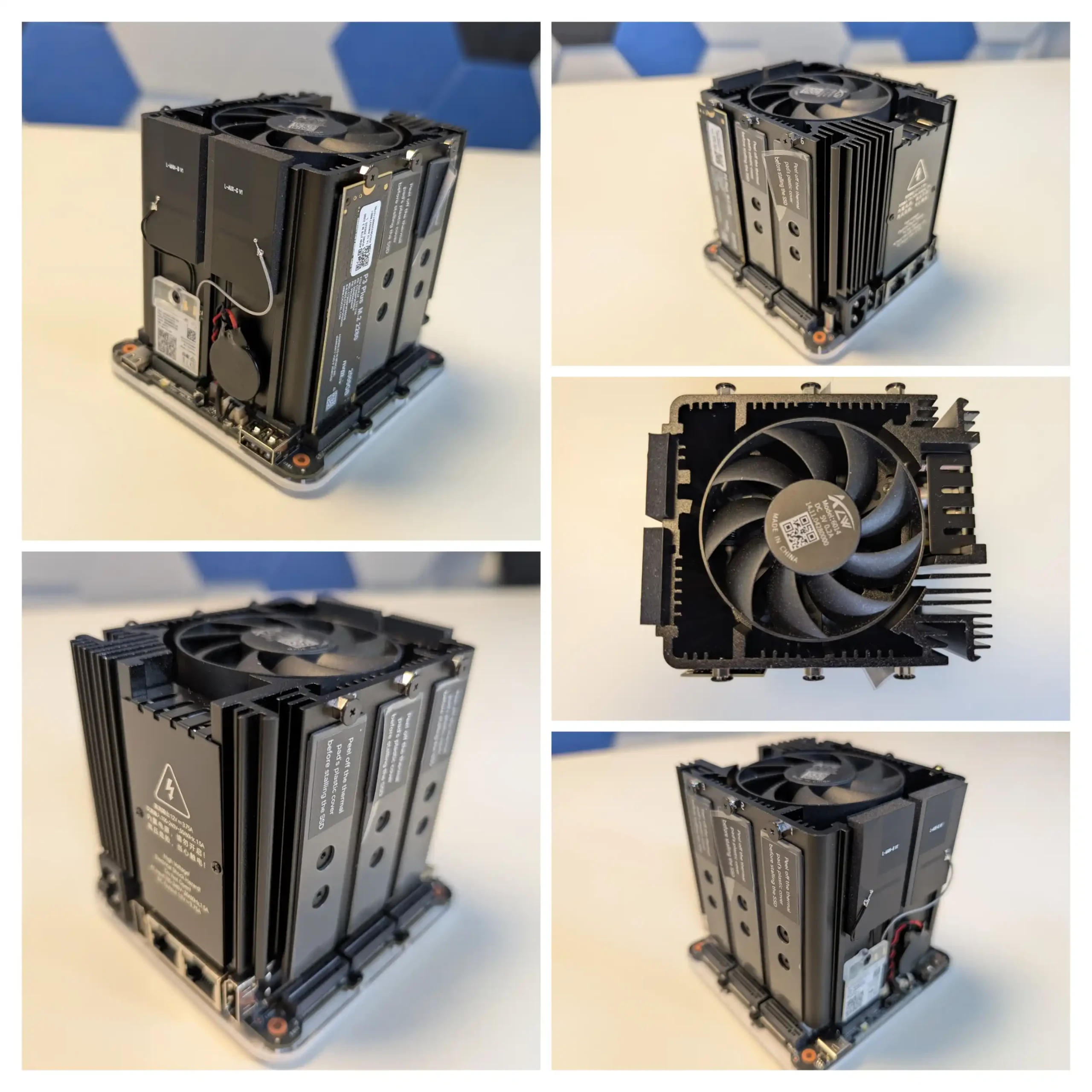
Internally, the layout is deliberately engineered to optimize thermal contact between the SSDs and the large aluminum heatsink at the center of the chassis. Each M.2 SSD slot is lined with a pre-applied thermal pad to ensure direct contact with the heatsink, enhancing passive cooling performance. This configuration is most effective with single-sided SSDs, though there is still clearance for some double-sided modules.
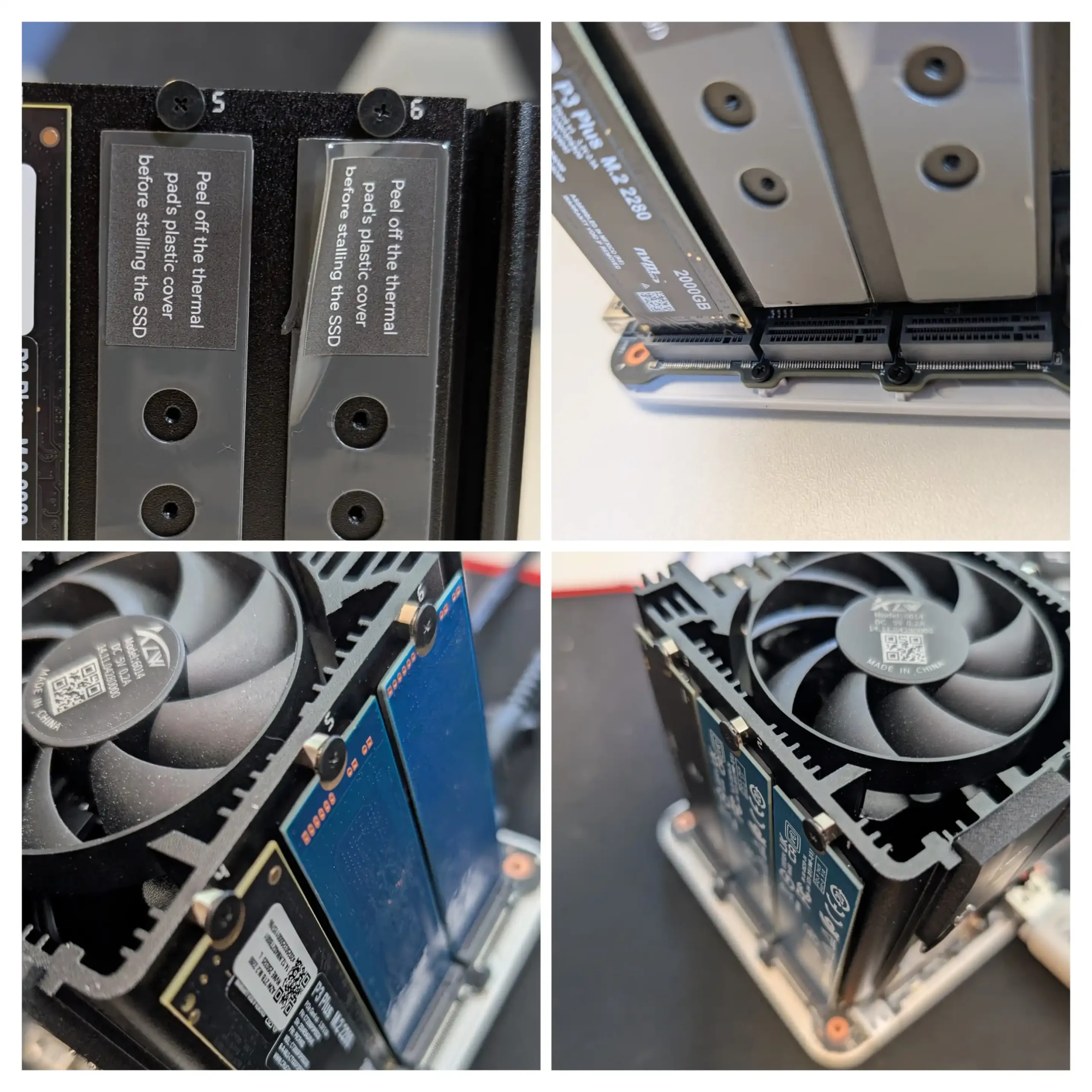
The passive heat management is further augmented by a silent fan located at the top, which provides active airflow without introducing noticeable noise—recorded at just 31–34 dBA during idle operation and up to 40 dBA under heavy load.
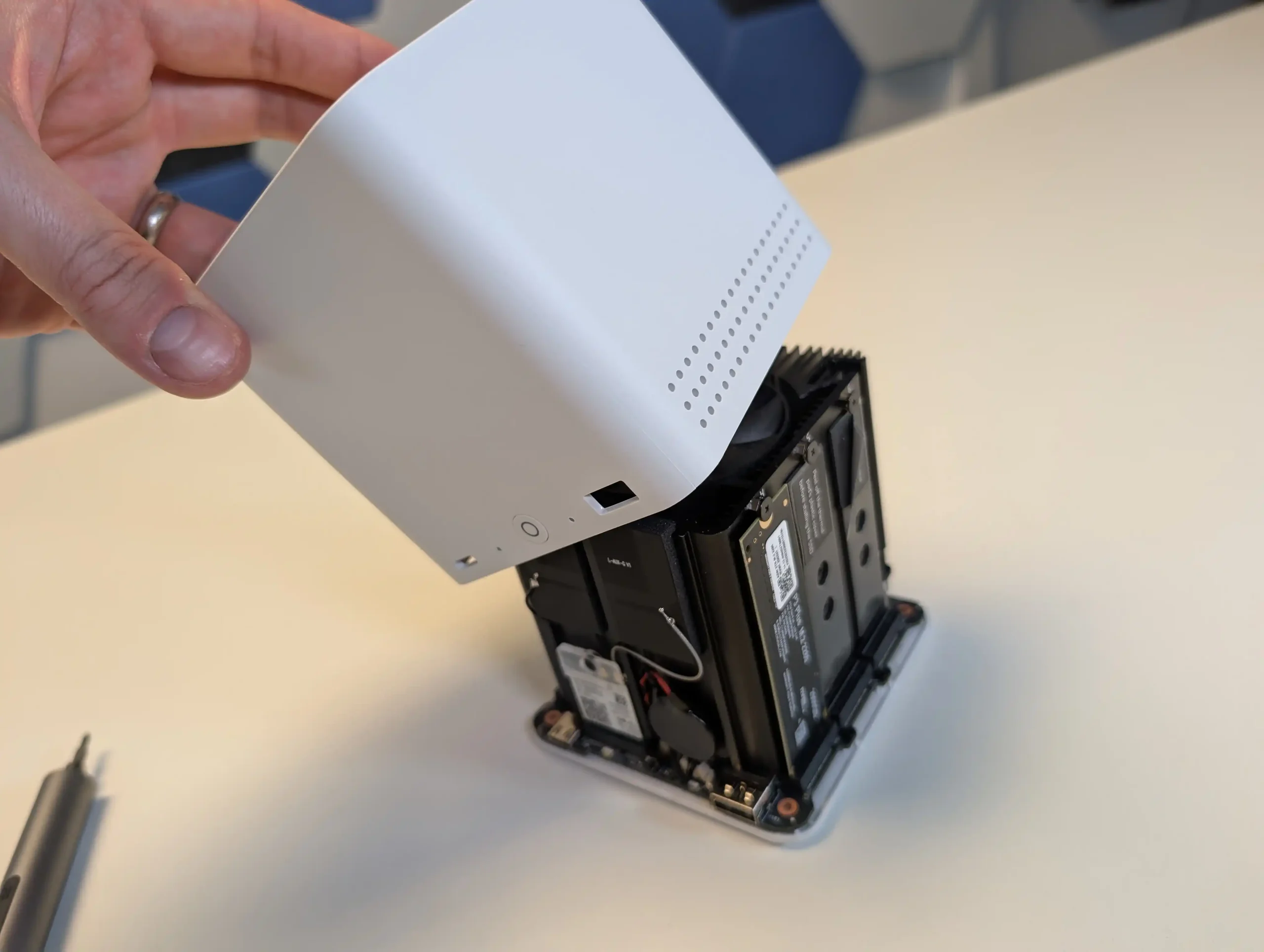
The ME Mini’s storage design is not intended for hot-swapping or tool-less drive changes, a reflection of its focus on home and small office environments where drives are installed once and left in place. While this may limit flexibility for enterprise workflows, it benefits reliability and aesthetics, especially considering the internal PSU, which would otherwise be challenged by fluctuating thermal loads from frequent disk changes.

The result is a closed, compact system that maximizes storage density while maintaining a fanless aesthetic from the exterior.

For users opting for pre-configured models, Beelink offers bundles that include Crucial P3 SSDs—either one 2TB unit or two 2TB units—depending on the chosen configuration. This co-branding with Crucial ensures a known level of SSD endurance and performance, contrasting favorably with many competing budget NAS options which often use generic or unverified storage media. The factory pairing also ensures that one of the SSDs is installed in the Gen 3 x2 slot, delivering better system responsiveness and transfer speeds for OS-hosted operations such as Plex metadata handling, RAID cache, or VM images.

Beelink ME Mini NAS – Internal Hardware
The internal hardware of the Beelink ME Mini centers around the Intel Twin Lake N150 processor, a 4-core, 4-thread chip based on Intel’s 10nm architecture. With a base TDP of 6W and burst frequency of up to 3.6GHz, it is positioned as a power-efficient solution for NAS tasks that include multimedia playback, basic file sharing, and light application hosting.
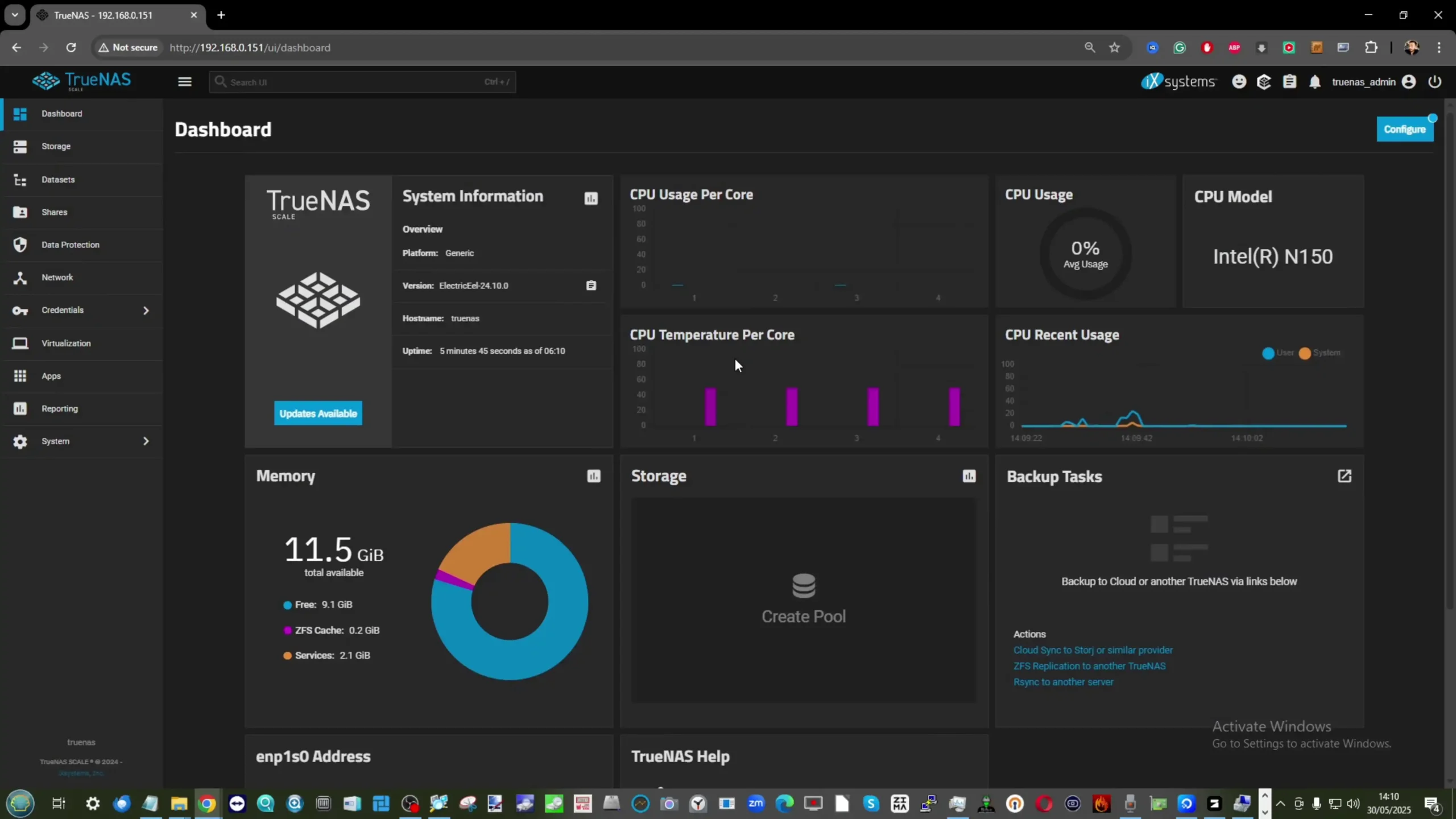
While it does not support hardware transcoding at the same level as higher-tier Intel core chips with Quick Sync, the N150 performs adequately for 4K playback in Plex and other media servers when transcoding is avoided. In real-world use, the CPU averaged 60–75% utilization during simultaneous dual 2.5GbE access and SSD activity, indicating a solid baseline for single-user or family scenarios.

Complementing the CPU is 12GB of LPDDR5 memory, soldered directly to the board and clocked at 4800MHz. While the memory is non-upgradable, the capacity is sufficient for running lightweight NAS OS environments, containers, or even some virtual machines.

Unlike most mini PCs that cap out at 8GB in similar thermal envelopes, Beelink’s decision to include 12GB offers a practical boost for users running multiple services, such as a media server alongside a VPN container or light file indexing applications. The absence of SO-DIMM slots means this cannot be expanded further, which may deter power users seeking a more scalable system, but the default capacity fits the ME Mini’s home-use intentions well.
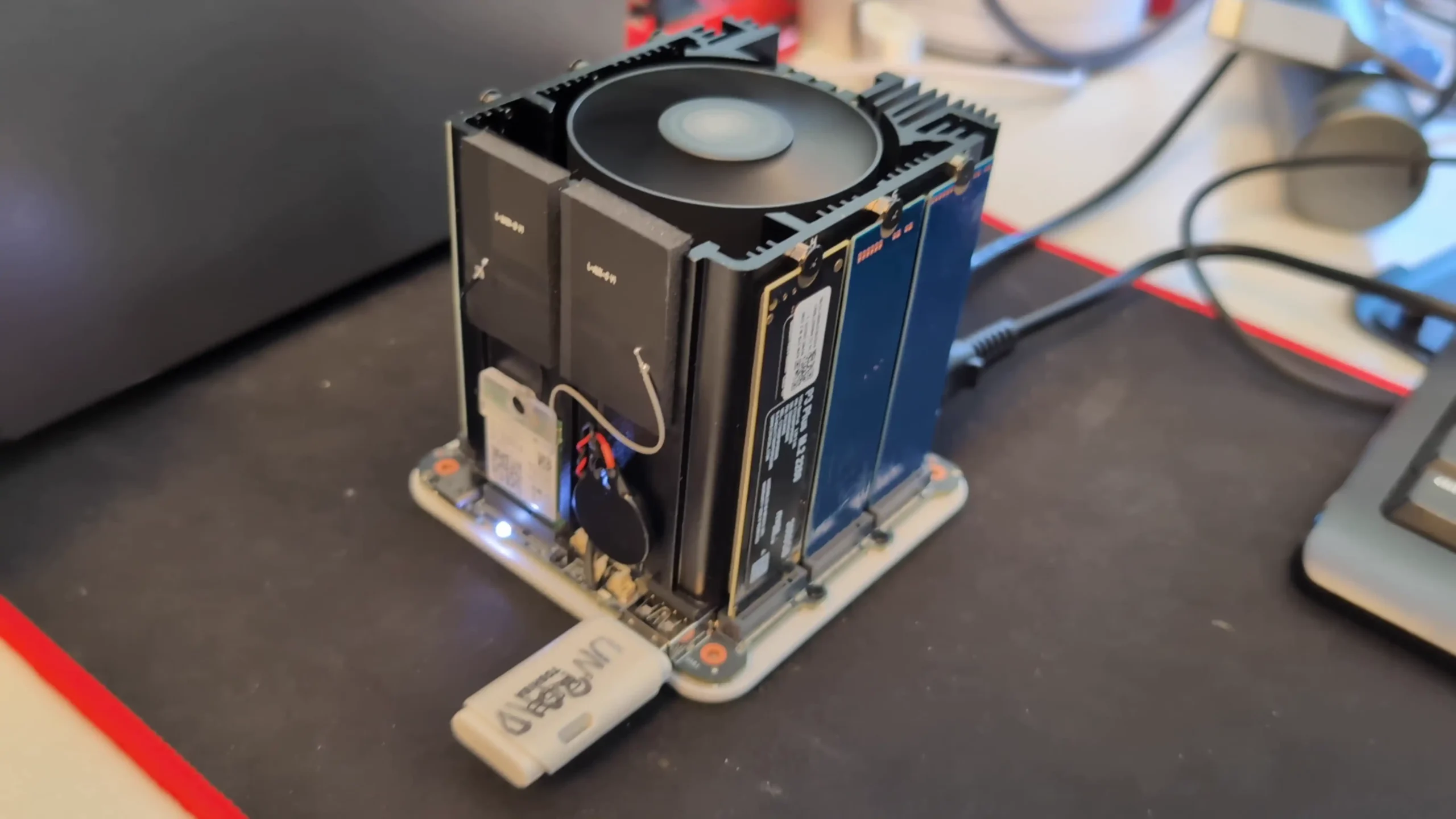
The overall thermal design pairs the CPU and SSDs with a centrally-mounted metal heatsink that acts as both a structural element and a cooling component. The silent fan located above the heatsink assists with vertical airflow, helping to maintain internal component temperatures during prolonged operation. During extended thermal tests—such as 24-hour idle and active file transfer sessions—surface temperatures peaked between 48°C and 60°C, particularly at the base where the PSU and networking ports reside.
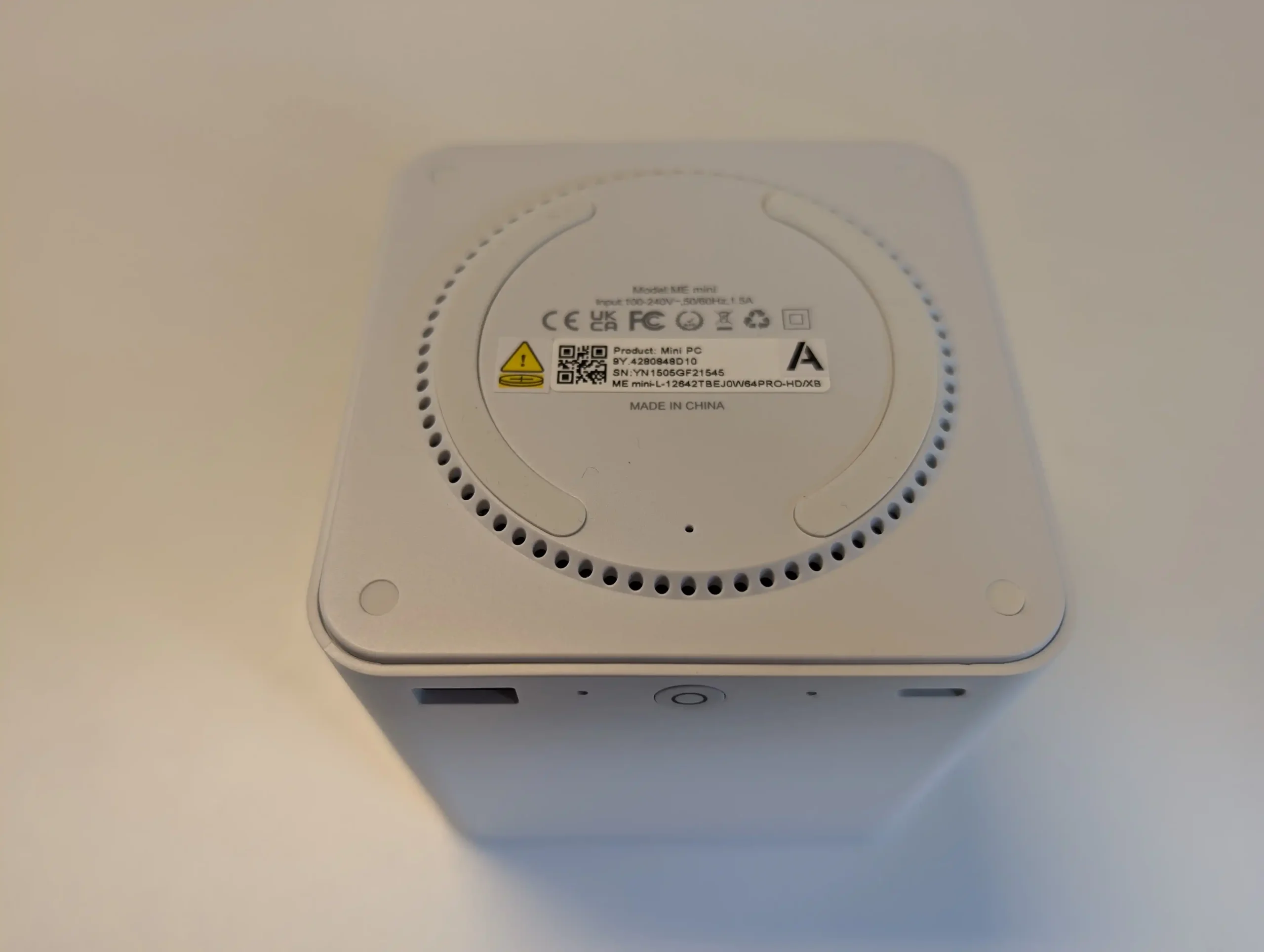
While the design keeps the main components within reasonable thermal ranges, there is a potential thermal buildup at the bottom under sustained load, suggesting an optional future design revision could include a base fan.
| Component | Specification |
|---|---|
| CPU | Intel Twin Lake N150, 4C/4T, 3.6GHz burst, 6W TDP |
| Memory | 12GB LPDDR5 (4800MHz, soldered, non-upgradable) |
| eMMC Storage | 64GB onboard |
| M.2 Storage | 6x M.2 2280 slots: 1x PCIe Gen 3 x2 (OS Recommended), 5x PCIe Gen 3 x1 |
| Cooling | Large internal heatsink + top-mounted silent fan |
| Thermals (avg) | 46–51°C top panel / 54–60°C bottom panel (under continuous load) |

Beelink ME Mini NAS – Ports and Connections
Despite its compact dimensions, the Beelink ME Mini includes a wide array of ports suited for both networking and peripheral connectivity. On the networking side, the unit features two 2.5GbE LAN ports (Intel i226-V), located at the rear, which support link aggregation or failover configurations. These enable transfer rates well above standard gigabit networking, although in practice, real-world throughput tends to be limited by SSD performance or PCIe lane constraints. During bandwidth testing, combined throughput between the LAN ports peaked around 580–600MB/s easily.

As much as many of us would want 10GbE – at this scale of CPU/Lanes, Price and just HEAT – I can understand why its absent here. That said, I do want to mention that the system includes onboard Wi-Fi 6 (via Intel AX101 module) and Bluetooth 5.2, expanding its use cases to wireless media streaming, mobile backups, and wireless NAS deployment without consuming physical LAN ports. More importantly though, UnRAID recently announced that in their latest update, you can now use wireless adapters (see below) – which, alongside UnRAID’s lightweight ‘on RAM’ deployment, makes it bloody IDEAL for using on the Beelink ME Mini
In terms of USB connectivity, the ME Mini provides a balanced selection across both older and high-speed standards. The rear I/O panel houses a USB 2.0 port (480 Mbps), while the front features one USB 3.2 Gen 2 port (10Gbps) and a USB Type-C port (also 10Gbps). This offers sufficient bandwidth for attaching external storage, keyboard/mouse input for system setup, or USB-based backup devices. While a higher count of USB 3.0+ ports might have benefitted users with multiple external drives, the available ports are positioned logically and suit the intended home-focused workflows.

Display output is provided via a single HDMI port located on the rear, which supports resolutions up to 4K at 60Hz. Although display output isn’t central to most NAS workflows, this port enables users to connect the system to a monitor or TV for initial OS installation, dashboard display, or media playback when used with platforms like LibreELEC or Kodi.
However, as noted during hands-on testing, functionality via HDMI may vary depending on the operating system installed—some headless NAS platforms may not fully support graphical output. Nevertheless, for users experimenting with hybrid HTPC/NAS setups or running Linux-based OS variants with a GUI, the HDMI port remains a useful inclusion.
| Port Type | Specification |
|---|---|
| LAN Ports | 2 x 2.5GbE (Intel i226-V) |
| Wi-Fi | Wi-Fi 6 (Intel AX101, M.2 module) |
| Bluetooth | Bluetooth 5.2 |
| USB Ports | 1 x USB 2.0 (rear), 1 x USB 3.2 Gen 2 (front), 1 x USB Type-C 10Gbps (front) |
| HDMI | 1 x HDMI 2.0 (Max 4K @ 60Hz) |
| Power Supply | Internal PSU with 100–240V AC input |
Beelink ME Mini NAS – Performance and Power/Heat/Noise Testing
In testing, the Beelink ME Mini demonstrated respectable throughput for a system of its class, especially when factoring in its compact size, low power draw, and passively biased thermal design. Using Unraid and TrueNAS Core for performance benchmarking, sequential read and write speeds from the five PCIe Gen 3 x1 slots averaged around 740MB/s read and 544MB/s write under repeated 1GB test files. These numbers are typical for Gen 3 x1 lanes and reflect near-maximum lane saturation, suggesting minimal internal throttling under standard conditions. The Gen 3 x2 slot, intended for the operating system, provided higher performance—averaging 1.1GB/s read and approximately 960MB/s write when paired with the bundled Crucial P3 SSD.
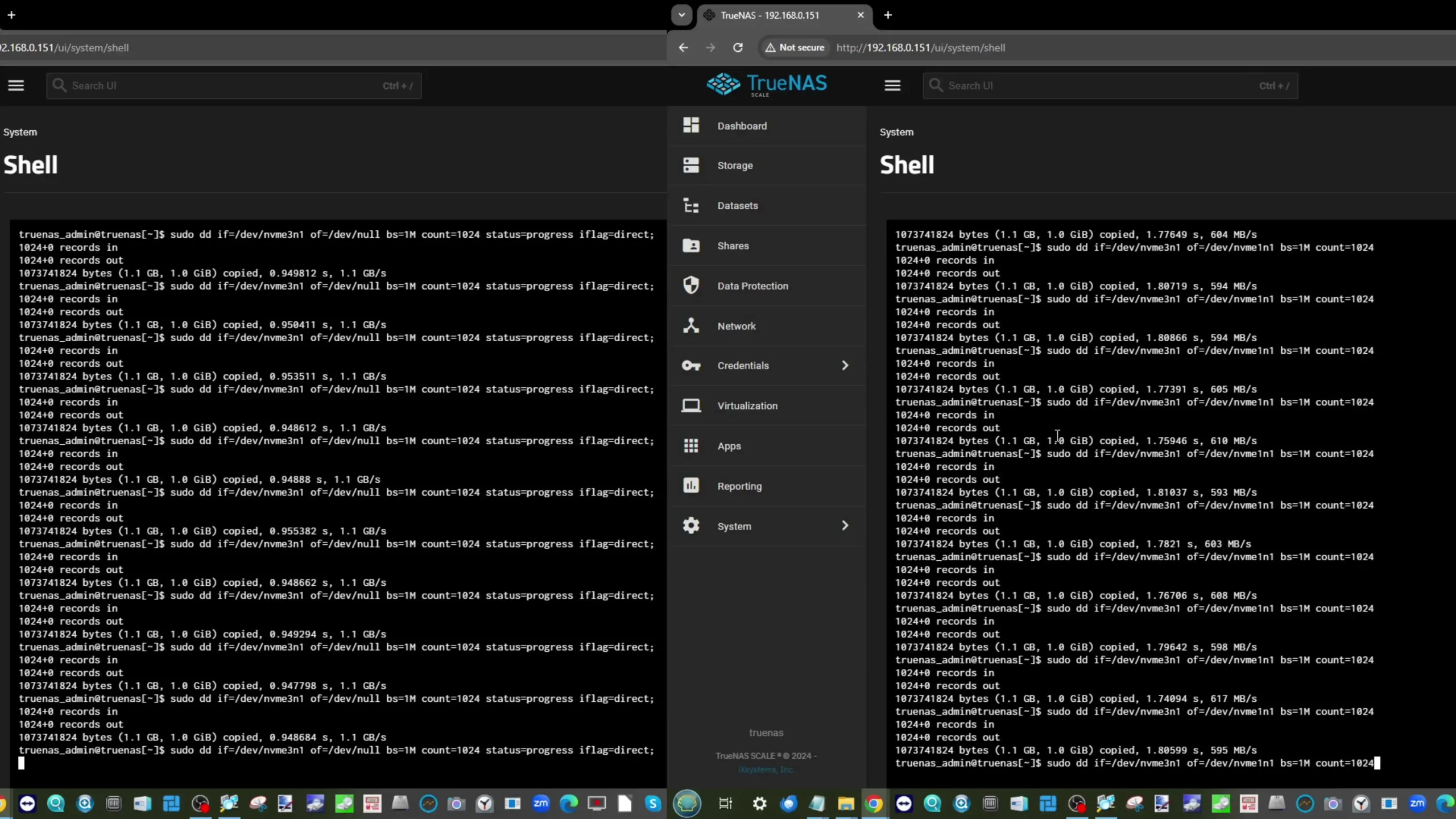
Transfer speeds between SSDs installed in Gen 3 x1 and Gen 3 x2 slots were tested in both directions and maintained averages of around 590–600MB/s. These figures reflect the limitations of internal bandwidth allocation rather than SSD performance. Even so, for most home NAS scenarios such as 4K media playback, multi-user access to stored documents, or photo libraries, the bandwidth is more than sufficient. It’s worth noting that SSD cooling remained effective during prolonged access, with only modest thermal variation even under full-speed transfers across all six drives.
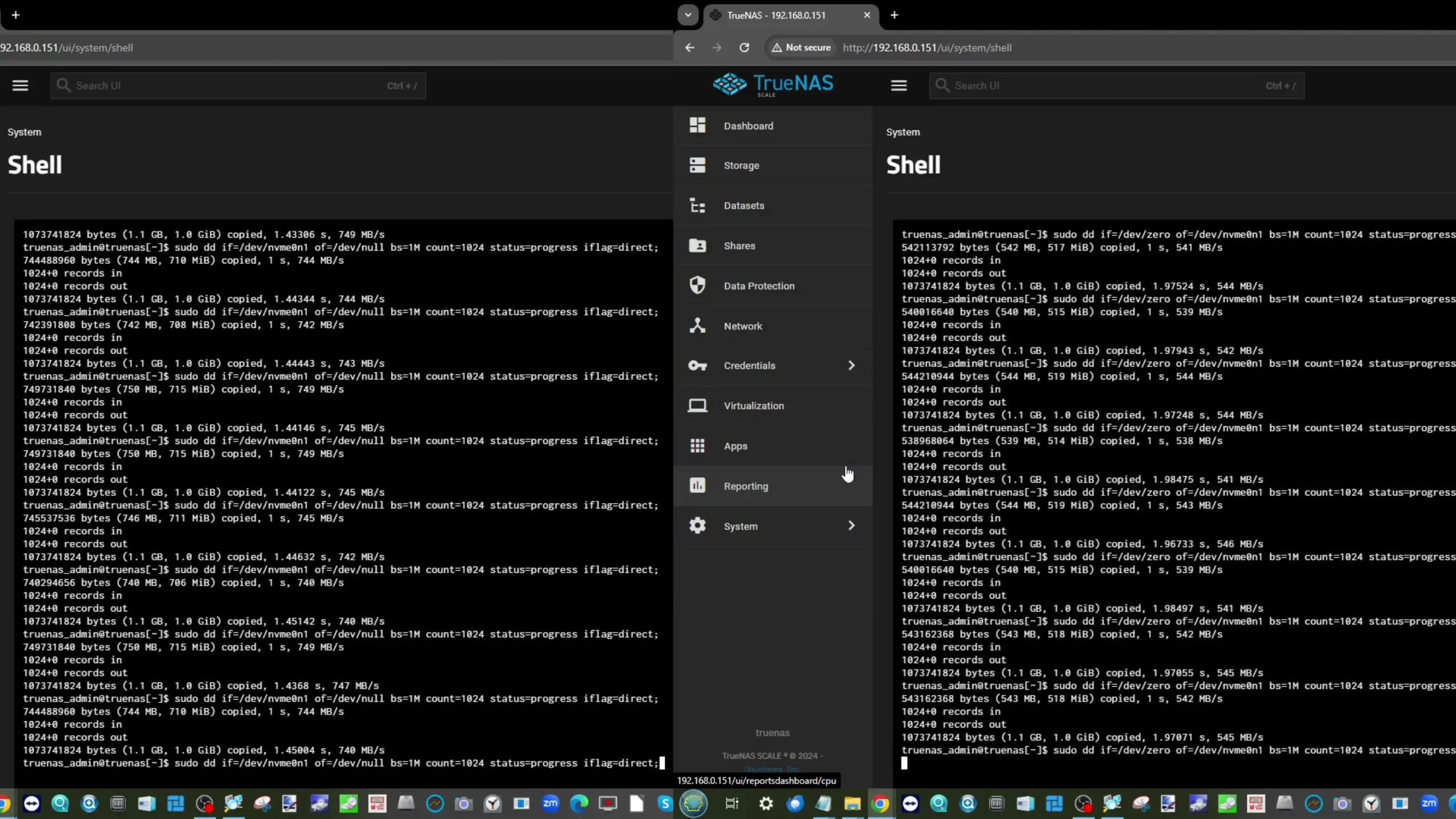
Thermal behavior during sustained load was closely monitored using a HIKMICRO thermal imaging camera. With all six SSDs installed and periodic access maintained over a 24-hour period, temperatures peaked at 48–51°C at the top panel and 58–60°C at the base, where most of the PSU and networking activity is concentrated. Running the same tests with the case removed saw temperatures settle slightly lower—around 49–51°C across the board—confirming the effectiveness of the internal heatsink and fan assembly. However, the bottom of the unit exhibited more thermal accumulation due to the lack of active ventilation underneath, pointing to an area for potential design refinement.

In terms of power consumption and noise, the ME Mini is especially frugal. With no SSDs installed, the device idled at 6.0–6.9W. When populated with six SSDs and left idle, it drew approximately 16.9W. During peak activity—dual LAN ports active, CPU load above 70%, and all drives in use—power draw peaked between 28W and 31W. These are competitive numbers even among ARM-based NAS devices, and particularly impressive for an x86-based solution with full M.2 NVMe storage.
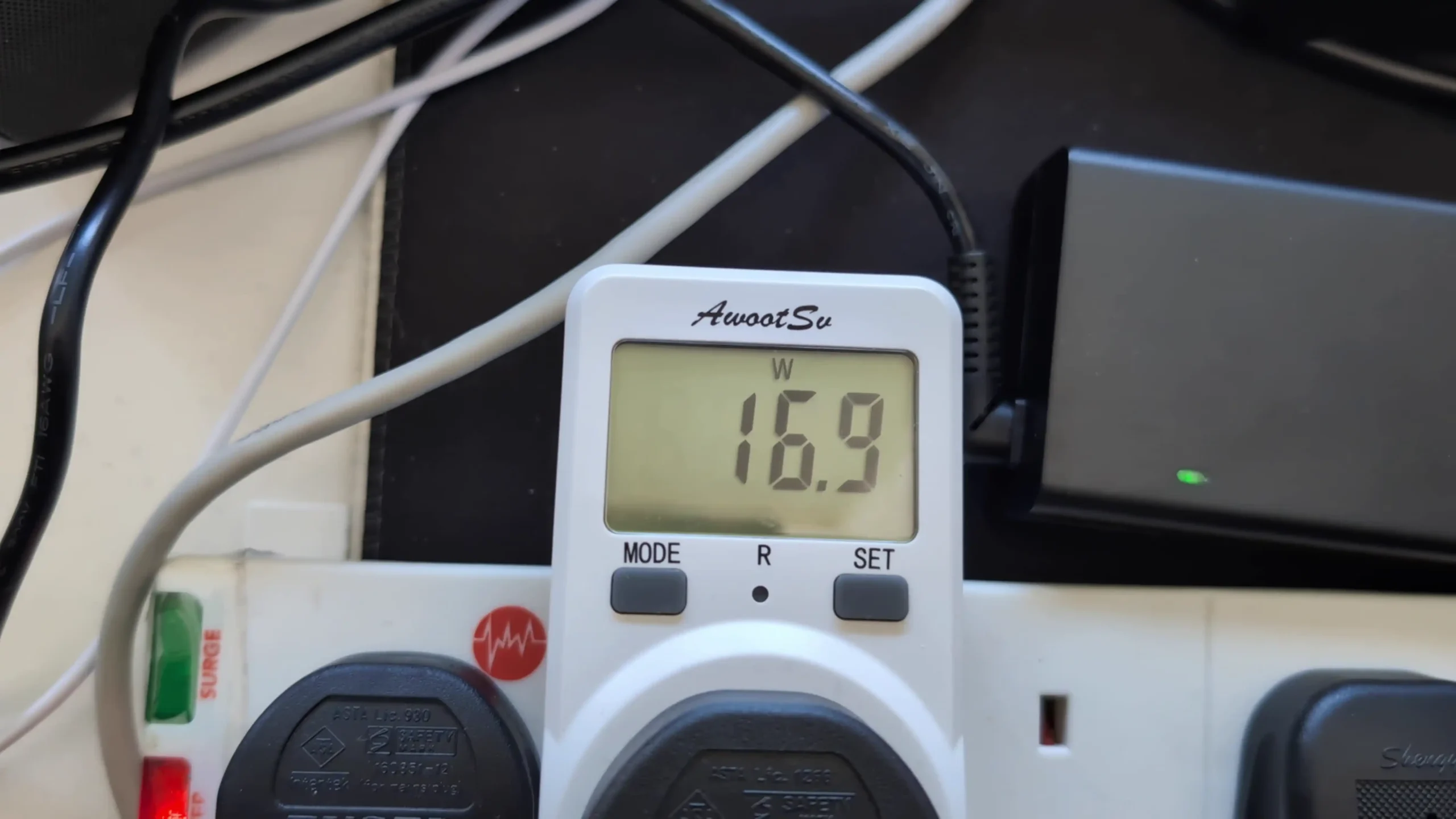 |
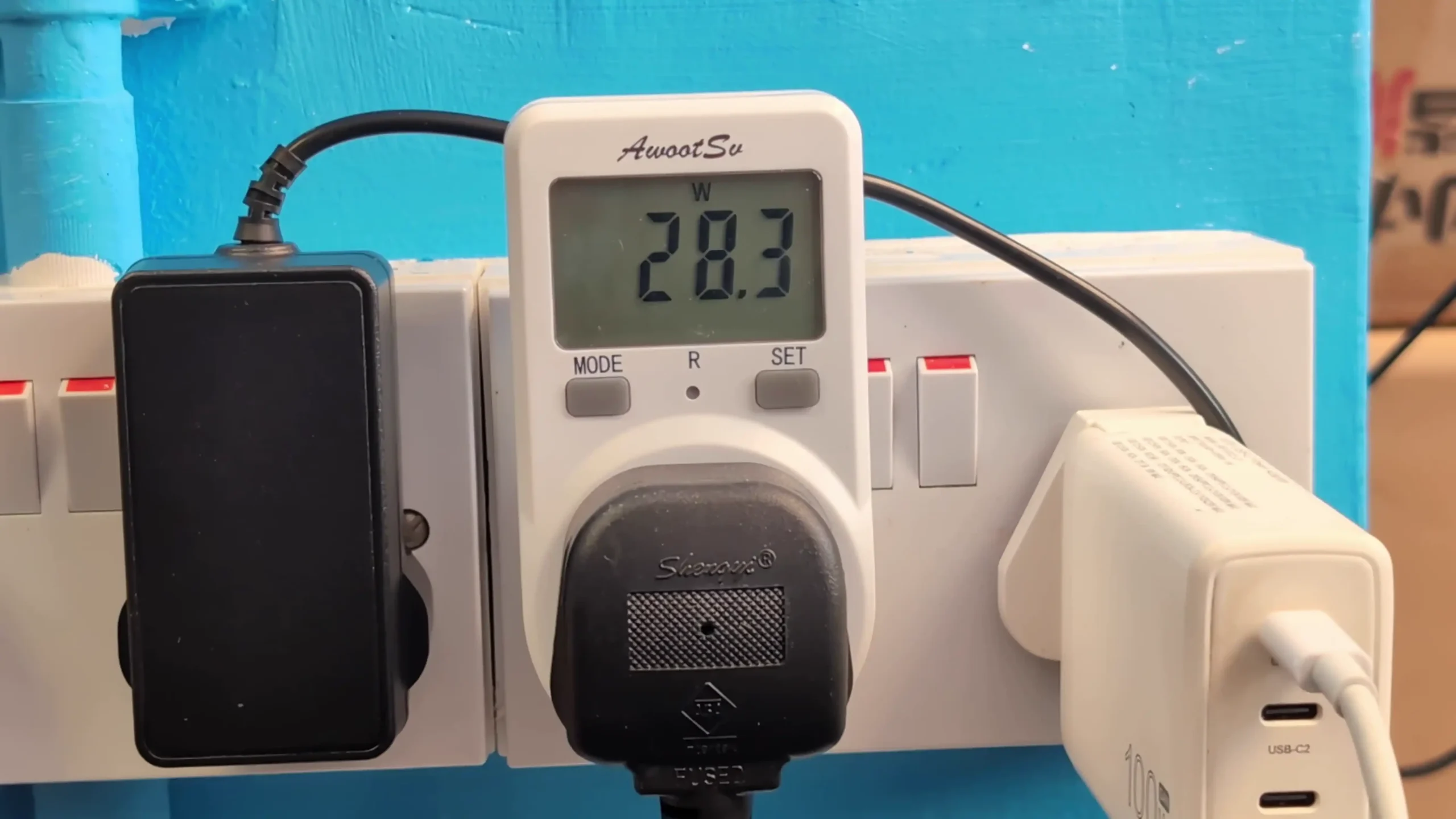 |
Acoustic output was also controlled, with idle operation measured at 31–34 dBA and full load peaking at just under 40 dBA—quiet enough for placement in shared living spaces without distraction.
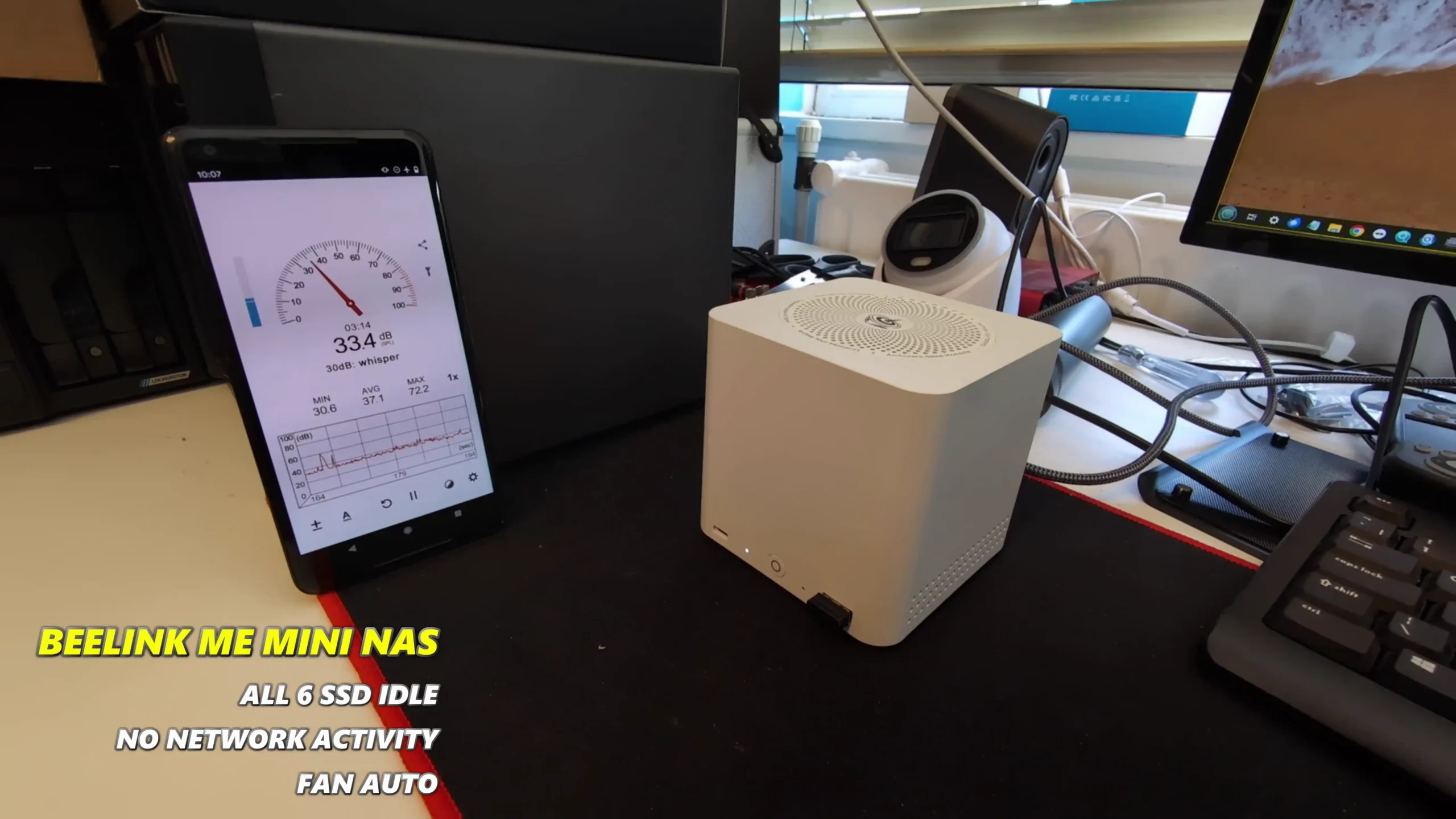 |
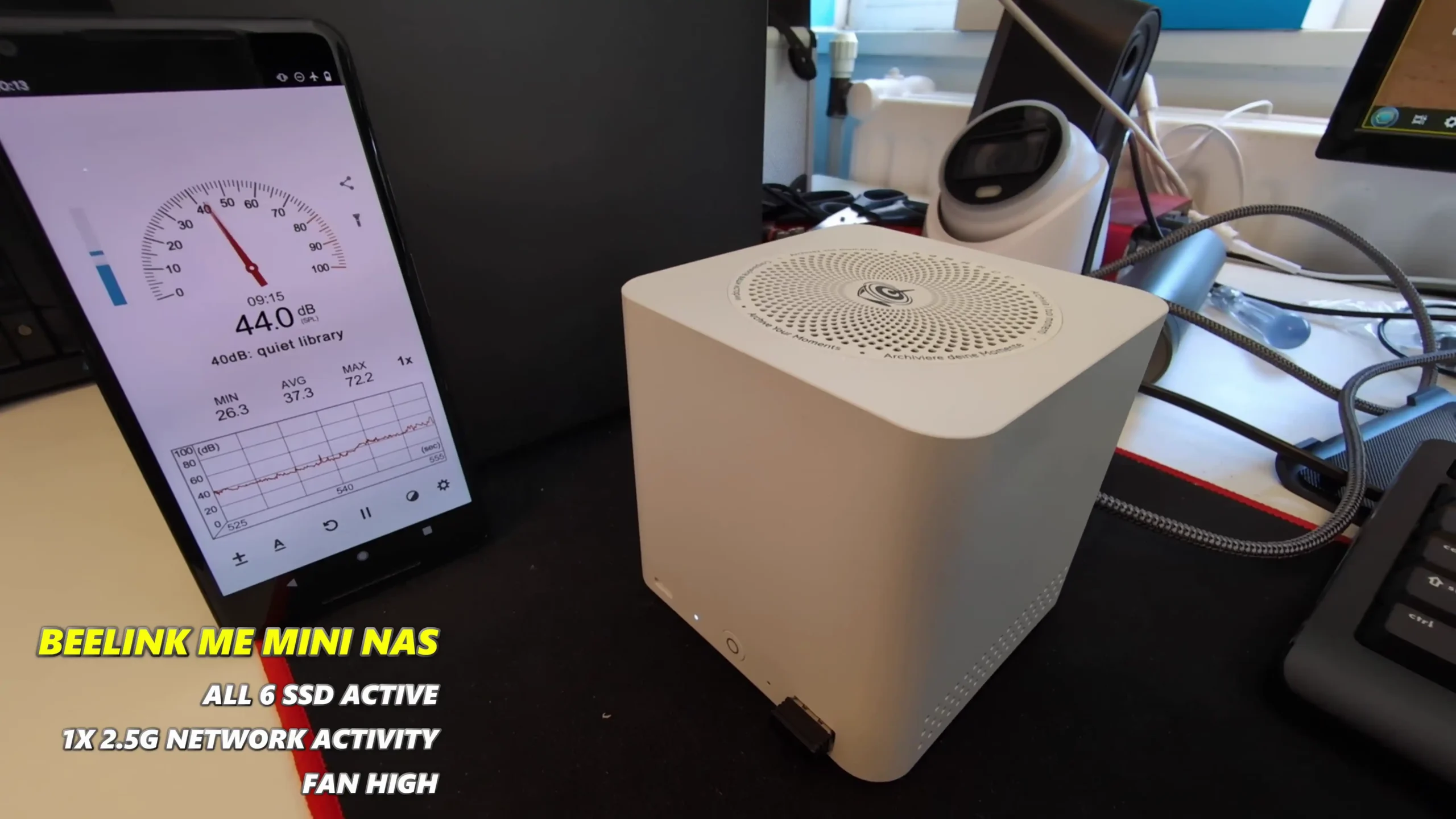 |
While performance is clearly limited by the Gen 3 x1 interface speeds on most slots, the device’s thermal and power efficiency arguably matter more for its intended audience. This NAS isn’t designed for high-throughput, multi-client virtualization tasks or heavy 10GbE video editing pipelines. Instead, it excels in delivering balanced, stable, and low-noise performance across general-purpose NAS workloads. For users building a Plex server, family backup archive, soft router, or even an experimental home lab appliance, the ME Mini offers just enough headroom to handle real-world demands without overwhelming complexity or cost.
Beelink ME Mini – Performance and Environmental Metrics (Over 3 Days)
| Test Scenario | Result/Reading |
|---|---|
| Read Speed (Gen 3 x1) | ~740MB/s |
| Write Speed (Gen 3 x1) | ~544MB/s |
| Read Speed (Gen 3 x2) | ~1.1GB/s |
| Write Speed (Gen 3 x2) | ~960MB/s |
| Inter-SSD Transfer | ~590–600MB/s |
| Idle Power Draw (No SSDs) | 6.0–6.9W |
| Idle Power Draw (6 SSDs) | 16.9W |
| Peak Load Power (Full Access) | 28–31W |
| Idle Noise Level | 31–34 dBA |
| Load Noise Level | 37–40 dBA |
| Avg. Top Panel Temp (Loaded) | 48–51°C |
| Avg. Bottom Panel Temp (Loaded) | 58–60°C |
Beelink ME Mini NAS Review – Verdict and Conclusion
The Beelink ME Mini NAS delivers an uncommon blend of size, functionality, and efficiency in a market segment often dominated by larger, louder, and less integrated alternatives. It is not designed to compete with traditional enterprise-grade NAS devices or modular, scalable solutions for prosumers. Instead, its strengths lie in targeting the needs of home users who want a quiet, energy-efficient storage solution that is easy to deploy, aesthetically unobtrusive, and capable of handling daily tasks such as media streaming, file backup, or soft routing. The inclusion of six M.2 NVMe SSD slots—paired with a Gen 3 x2 system slot—offers a rare level of expansion in such a small enclosure. The integration of an internal PSU, silent fan-assisted cooling, and a surprisingly effective thermal design are thoughtful touches that differentiate it from the majority of DIY NAS mini PCs.
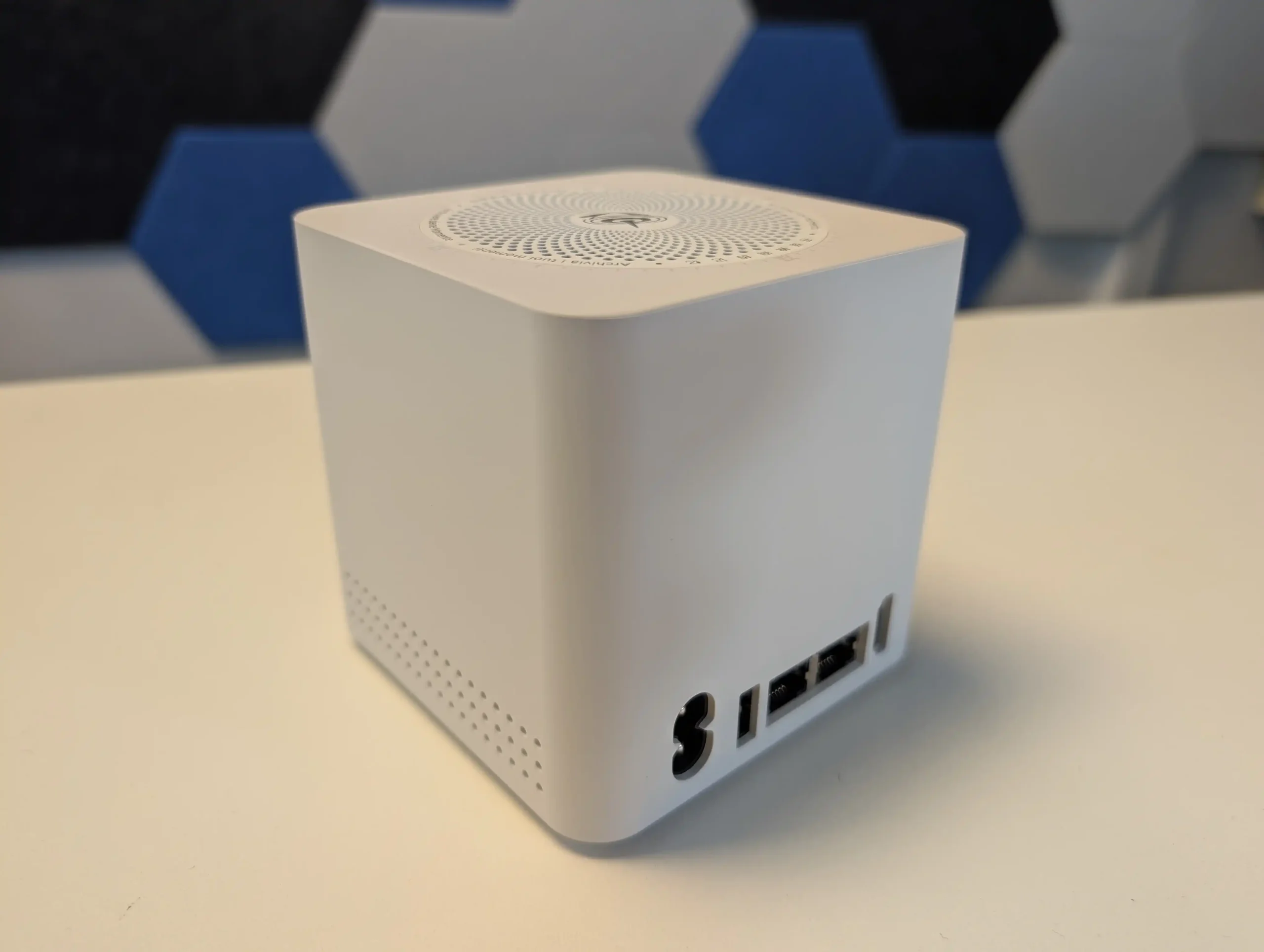 |
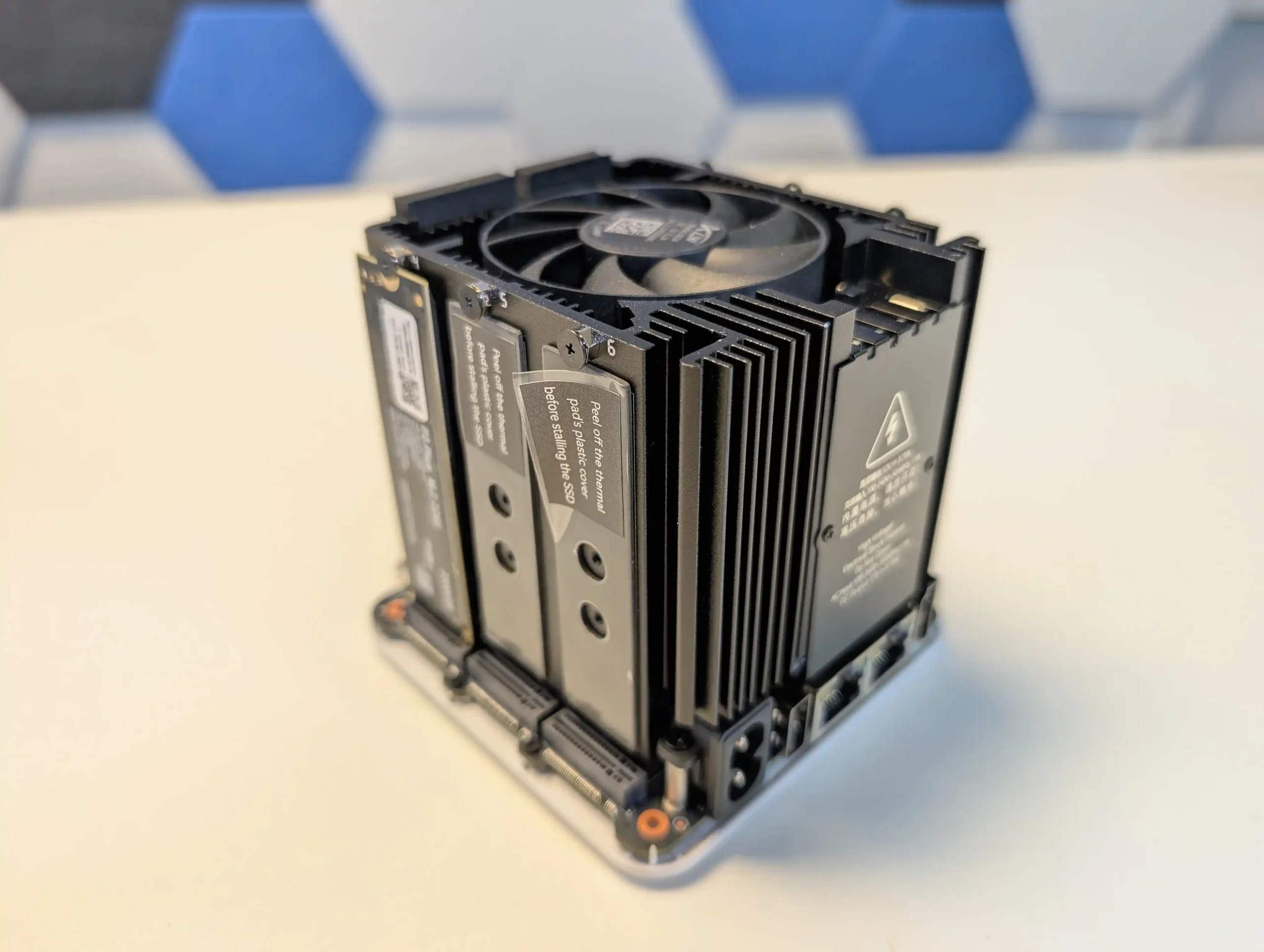 |
That said, it is not without limitations. The memory is non-upgradable, thermal accumulation at the base suggests room for improvement, and bandwidth ceilings imposed by Gen 3 x1 lanes will constrain users who demand high parallel throughput. Still, for its price point—particularly when pre-order discounts are applied—the ME Mini offers significant value, especially when compared to ARM-based NAS solutions with similar or lower specifications. With bundled Crucial SSD options and support for a wide range of NAS operating systems, it positions itself as a ready-to-go platform for tech-savvy users wanting to avoid the assembly of a fully DIY system. Overall, while not a product for every use case, the Beelink ME Mini succeeds in its aim to be a compact, stylish, and capable home NAS.
| Pros | Cons |
|---|---|
| Compact cube design (99x99x99mm) ideal for discreet home deployment | Memory is soldered and non-upgradable |
| Supports up to 6x M.2 NVMe SSDs with total capacity up to 24TB | Five of the six SSD slots are limited to PCIe Gen 3 x1 bandwidth |
| Integrated PSU eliminates bulky external power adapters | Bottom panel retains heat due to lack of active ventilation |
| Dual 2.5GbE LAN ports with link aggregation support | — |
| Wi-Fi 6 wireless access and flexibility in UnRAID7 | — |
| Low power consumption (as low as 6.9W idle, ~30W peak with full load) | — |
| Silent fan and effective internal thermal management via large heatsink | — |
| Includes Crucial-branded SSDs in pre-configured options for reliability | — |
|
Check Amazon in Your Region for the Beelink ME Mini NAS ($329 4/6) |
Check AliExpress for the Beelink ME Mini NAS ($344 4/6) |
Check the Official Beelink Site for the ME Mini NAS ($209 4/6) |
 SUBSCRIBE TO OUR NEWSLETTER
SUBSCRIBE TO OUR NEWSLETTER 
[contact-form-7]
 Join Inner Circle
Join Inner Circle Get an alert every time something gets added to this specific article!
 Subscribe
Subscribe
This description contains links to Amazon. These links will take you to some of the products mentioned in today's content. As an Amazon Associate, I earn from qualifying purchases. Visit the NASCompares Deal Finder to find the best place to buy this device in your region, based on Service, Support and Reputation - Just Search for your NAS Drive in the Box Below
Need Advice on Data Storage from an Expert?
Finally, for free advice about your setup, just leave a message in the comments below here at NASCompares.com and we will get back to you. Need Help?
Where possible (and where appropriate) please provide as much information about your requirements, as then I can arrange the best answer and solution to your needs. Do not worry about your e-mail address being required, it will NOT be used in a mailing list and will NOT be used in any way other than to respond to your enquiry.
[contact-form-7]
Need Help?
Where possible (and where appropriate) please provide as much information about your requirements, as then I can arrange the best answer and solution to your needs. Do not worry about your e-mail address being required, it will NOT be used in a mailing list and will NOT be used in any way other than to respond to your enquiry.
[contact-form-7]
 Ko-fi or old school Paypal. Thanks!To find out more about how to support this advice service check HEREIf you need to fix or configure a NAS, check Fiver
Have you thought about helping others with your knowledge? Find Instructions Here
Ko-fi or old school Paypal. Thanks!To find out more about how to support this advice service check HEREIf you need to fix or configure a NAS, check Fiver
Have you thought about helping others with your knowledge? Find Instructions Here

|
 |



